After Yang is a beautiful, sublime, and ultimately minimal film about family identity and memory. The titular Yang is played by Justin H. Min, whose lightning-in-a-bottle performance as the android (“technosapien”) babysitter is barely-there but grounds the film’s emotional core. This isn’t a high drama film that begets spoiler warnings, but I recommend seeking it out.
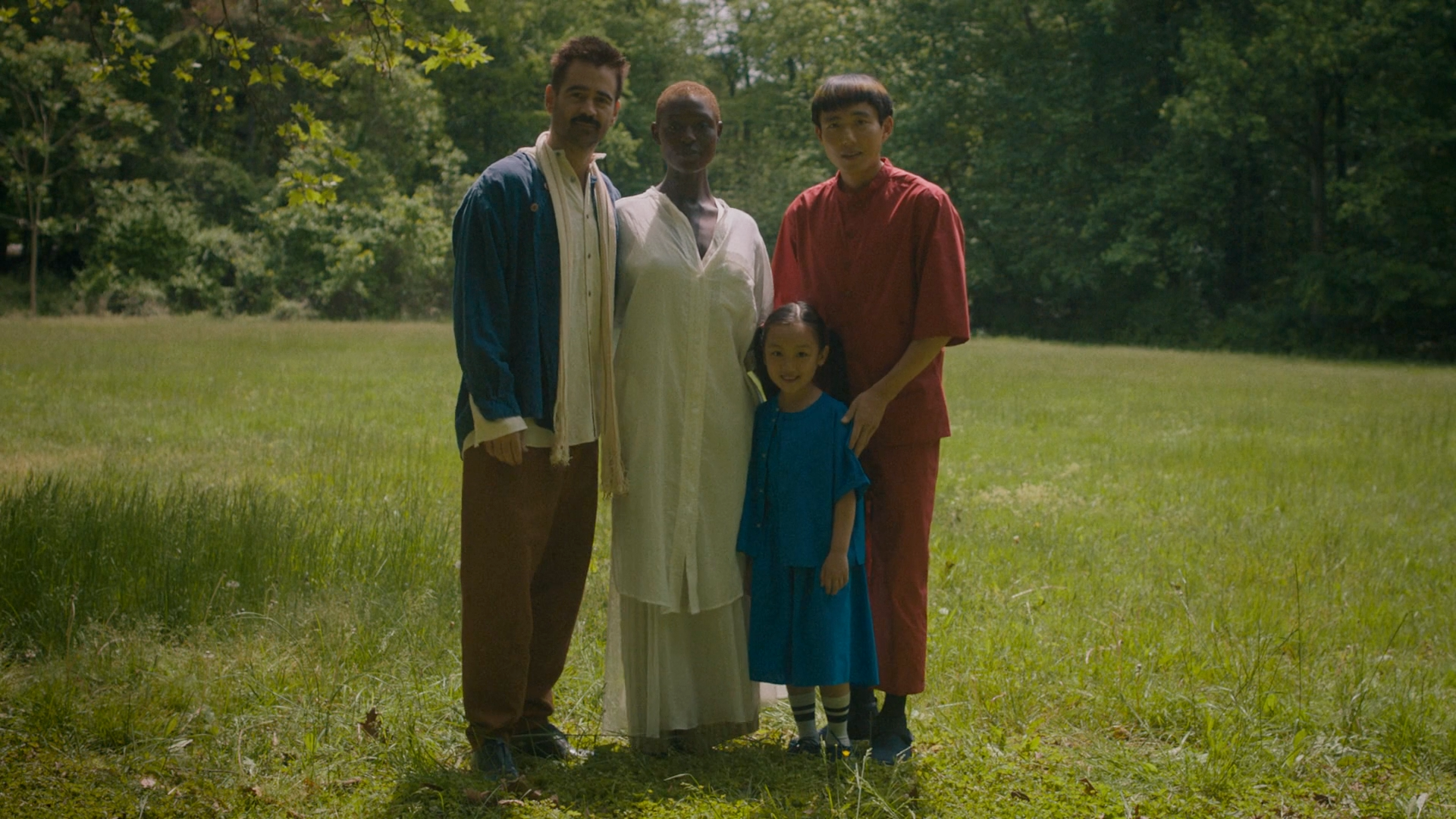
The time and place of After Yang is ambiguous. Decades or hundreds of years into the future are all probable scenarios. This ambiguity is supported by the film’s unobtrusive technology. The technology that is on-screen is nearly unrecognizable. Yang, himself, is made of technology. The self-driving cars feel more like extensions of the home with comfortable lounge seating and plants to soften the space. Video-chatting occurs with no apparatuses present. Fittingly, Yang is seen using a vintage Pentax K1000 camera (“He loves that old camera”) shortly after taking his own mental snapshot. These memories are archived on a crystal cube the size of a large pair of dice, accessed by a console that looks like Morpheus’ sunglasses in The Matrix.
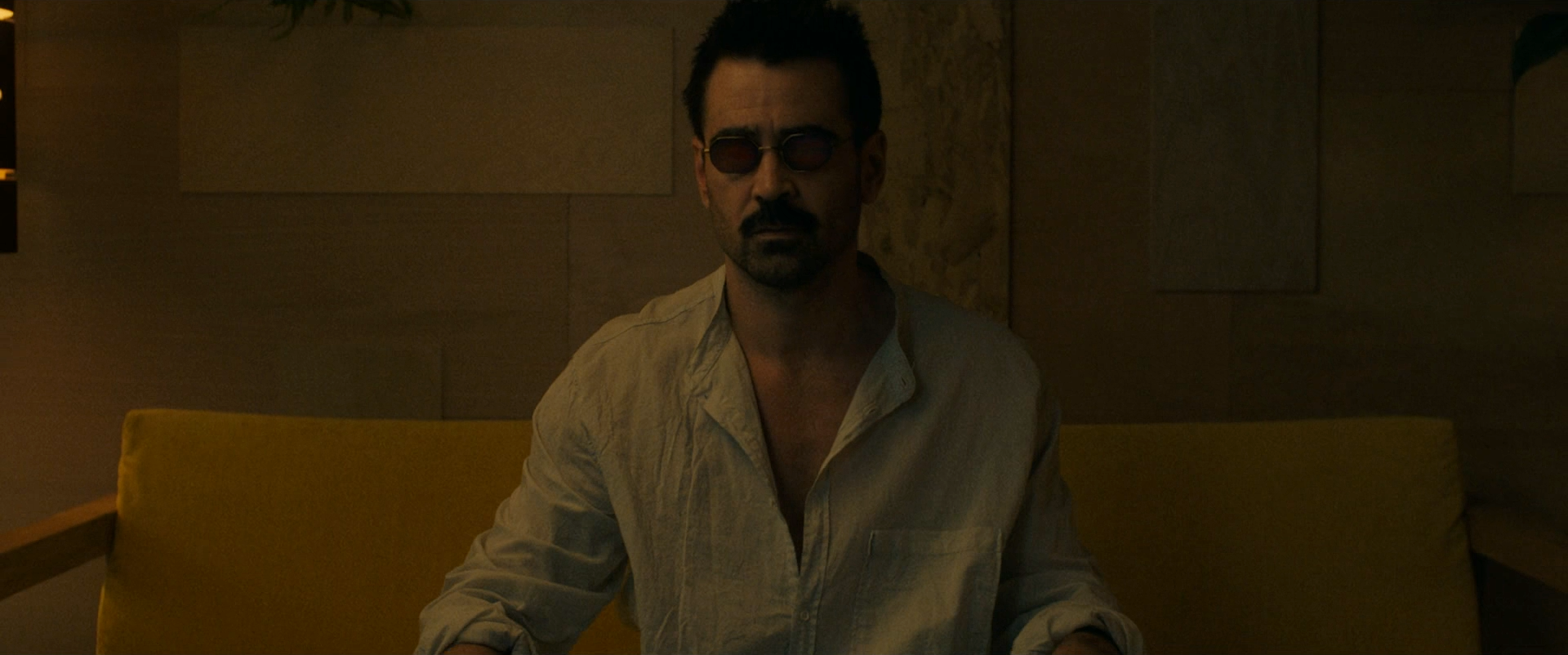
The film is also ambiguous with place, but there are subtle clues. The actors keep their natural Irish, British, and American accents. The rare establishing shots show American landscapes, geodesic domes, and home and garden accents that are distinctly East Asian and Nordic modern. But this multiculturalism does not mean it’s an anti-racist utopia. A sign in Russ’ shop reads “There ain’t no yellow in the red, white, and blue” alongside newspaper clippings with headlines about a long war involving the US and China. These general details are kept from Alexander Weinstein’s short story Saying Goodbye to Yang which appears in “Children of the New World” (link: Goodreads). This very short read further explains the characters of Russ and George and their racism and xenophobia (as well as a a secret, third thing). However, the film does not dwell on this and, regardless, it is safe to assume from other cues that After Yang is set in the West after a significant period of influence from the East. This techno-orientalism is nothing new for science fiction. It is also a main conversation point for the story (link: New Yorker – “Where the Future Is Asian, and the Asians Are Robots”). After all, Yang is originally only seen as a guide for Mika to understand her branch-grafted identity and is discovered to be much more.
In the absence of definite details about the time and location, After Yang is an exceptional example of costuming to establish place.
I’d like to start at the beginning: The film’s utterly fantastic opening credits dance scene.
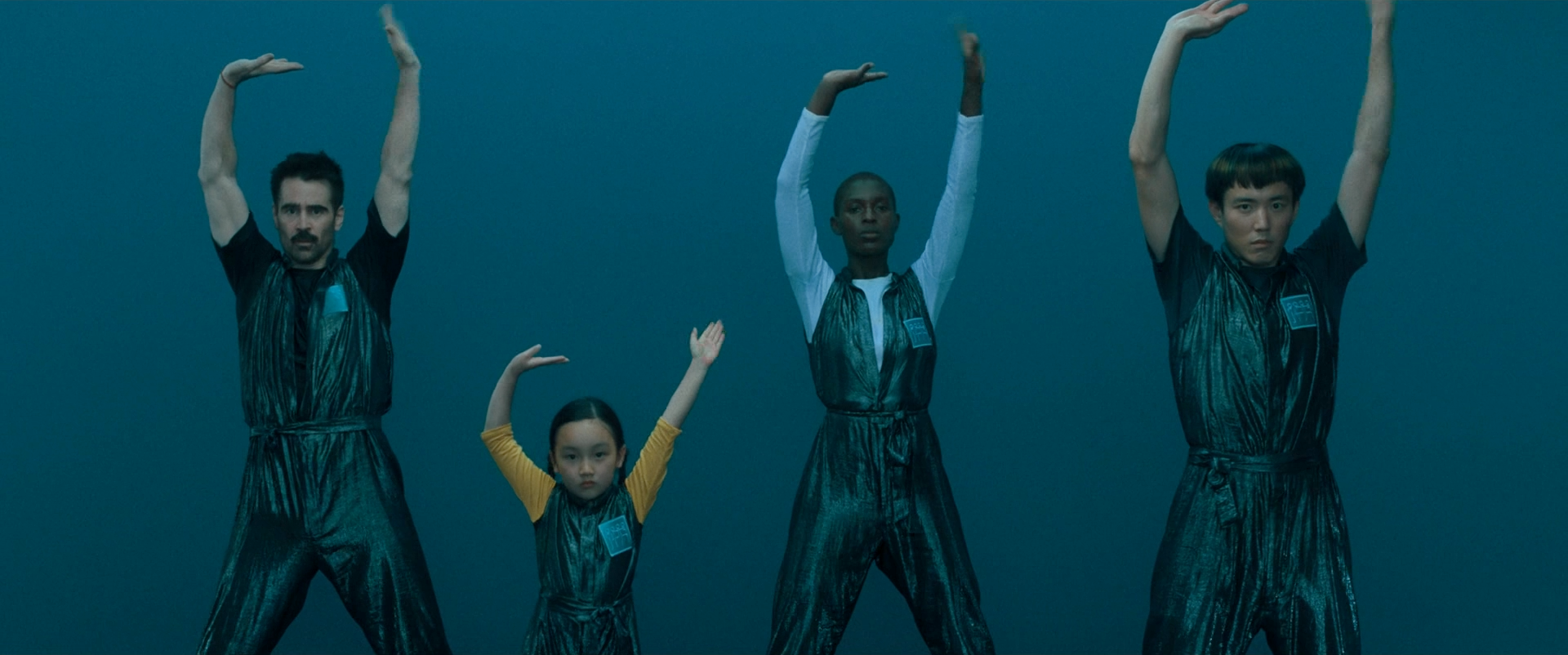
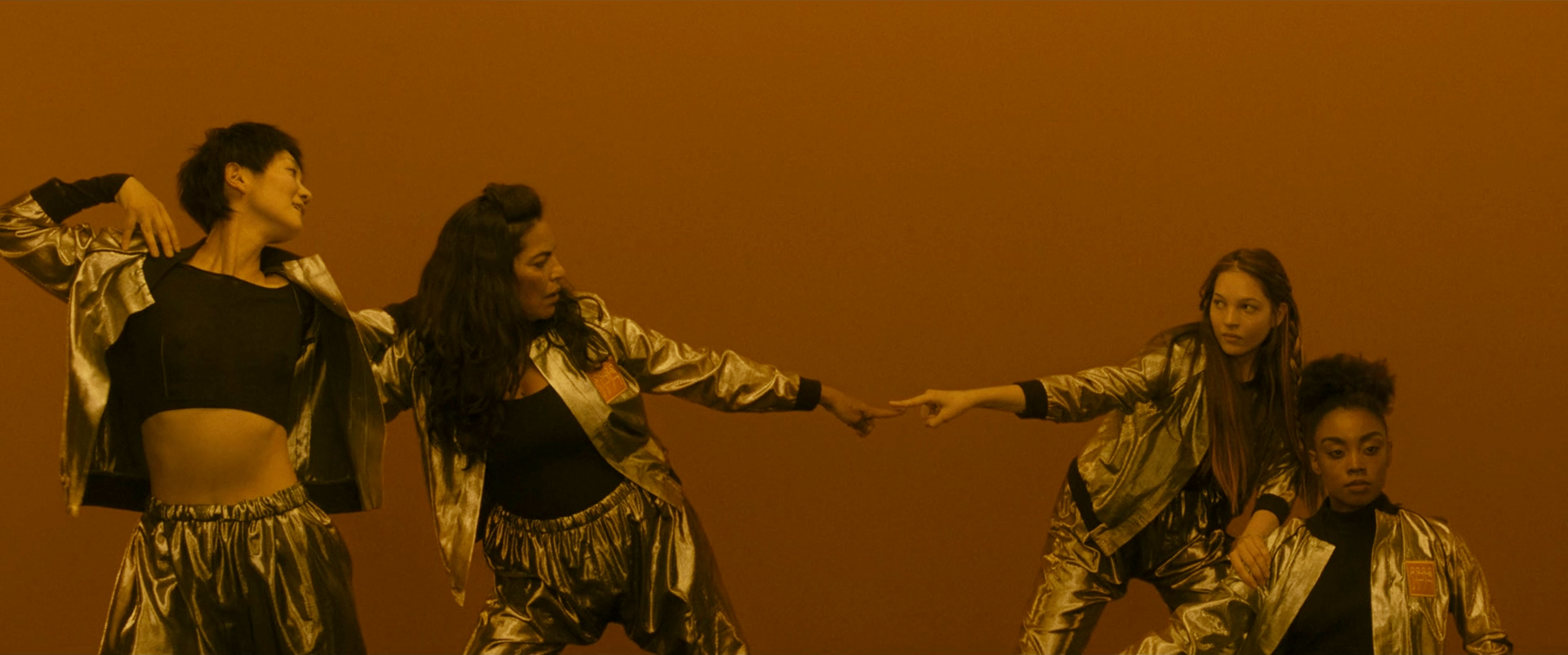
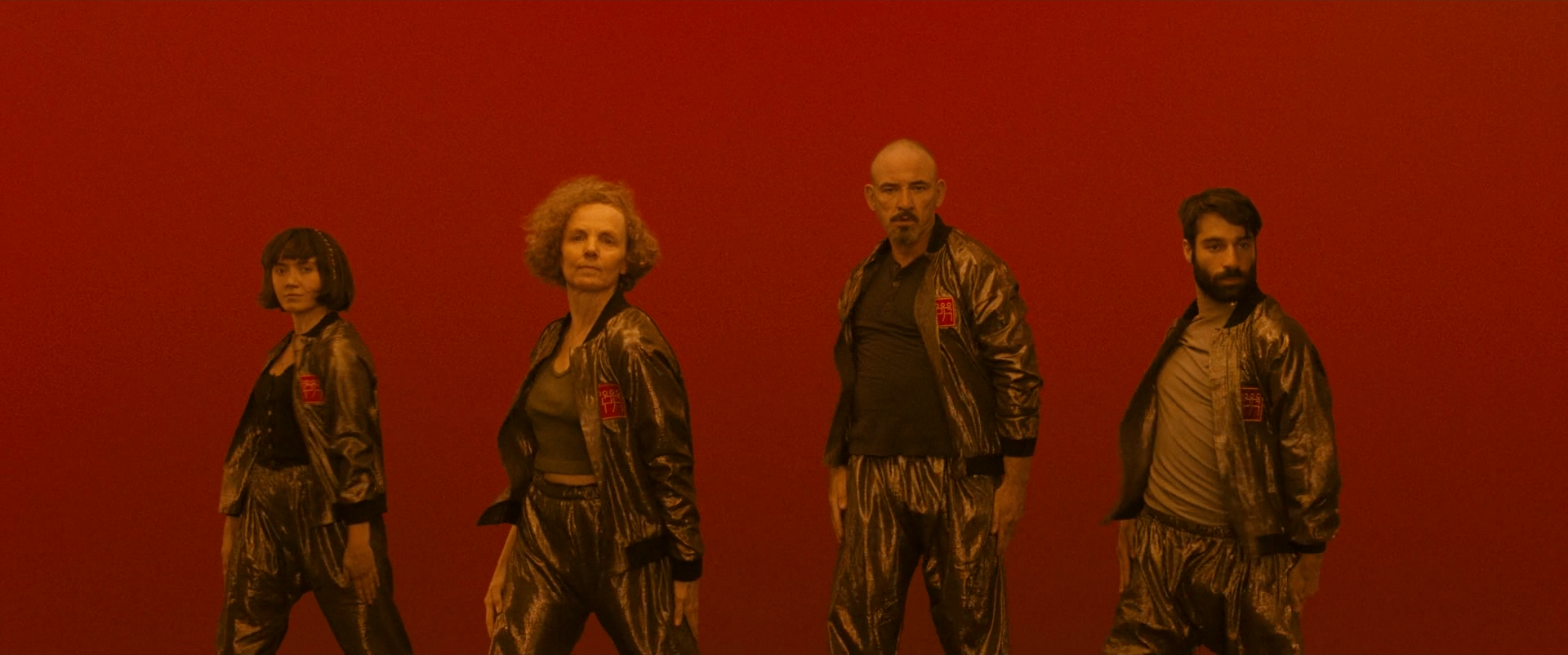
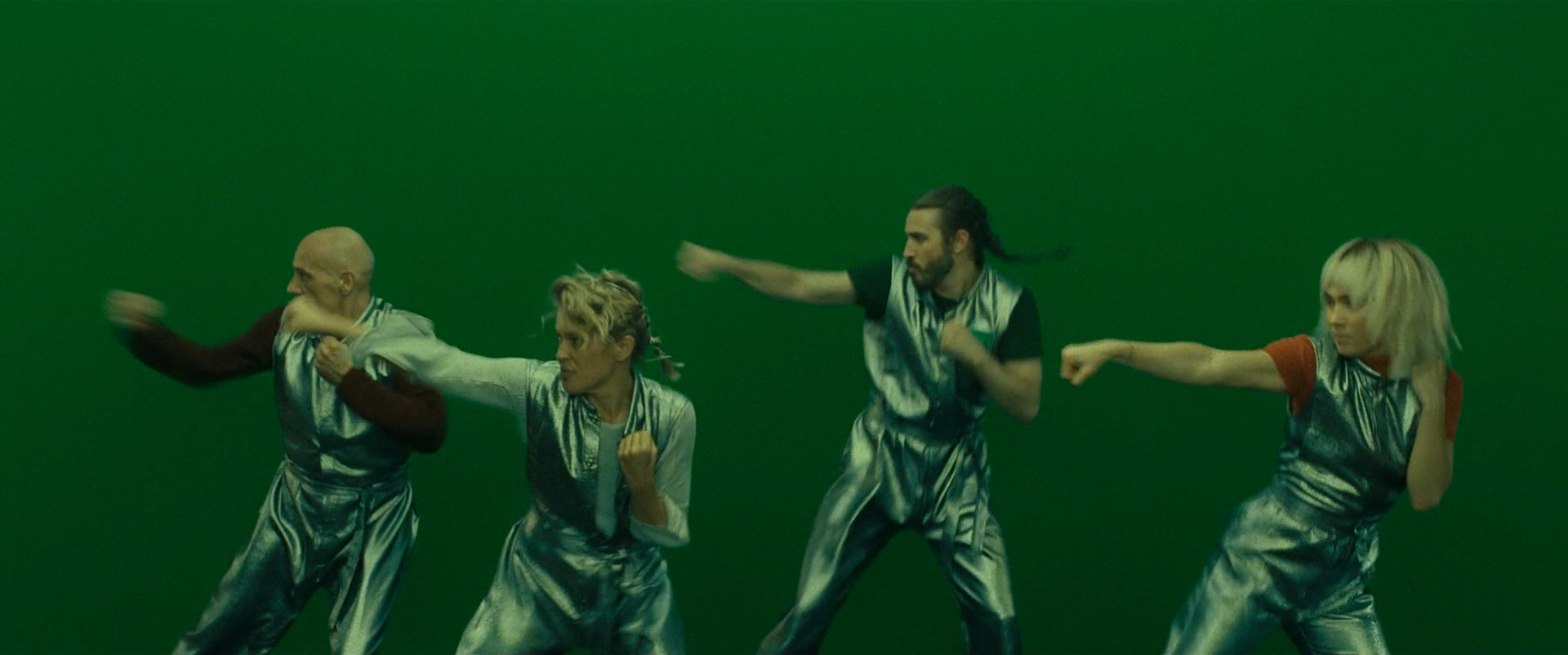
The families engage in an online dance battle similar to Dance Dance Revolution or Just Dance. I like to think that these garments are wearable input devices/controllers. Texture is very important for the visual language of the clothing in the film and this is the only prominent time we see shine or any fabric that isn’t matte. This is a clue that the garments are special and separate in their use. My best guess for the fabric is a silk or synthetic/foiled dupioni. While definitely not an athletic fabric in the current age, the luster of the fabric in the lighting and in front of the backdrop is stunning.
I personally love that the garments are not singular. We see jackets, jumpsuits that button up, jumpsuits that are bibbed, and small personal styling touches for each individual in a cohesive unit. There is something so funny about families taking a fun activity so seriously that they dress up in matching crew outfits. But that’s also why it works so well as an opener- it leaves no question in your mind that this movie is about the family unit.
Beyond the fun intro, After Yang is great at displaying a zeitgeist of trends while also displaying a distinct generational sense of dressing. One of my favorite examples of this is Ada’s wardrobe.
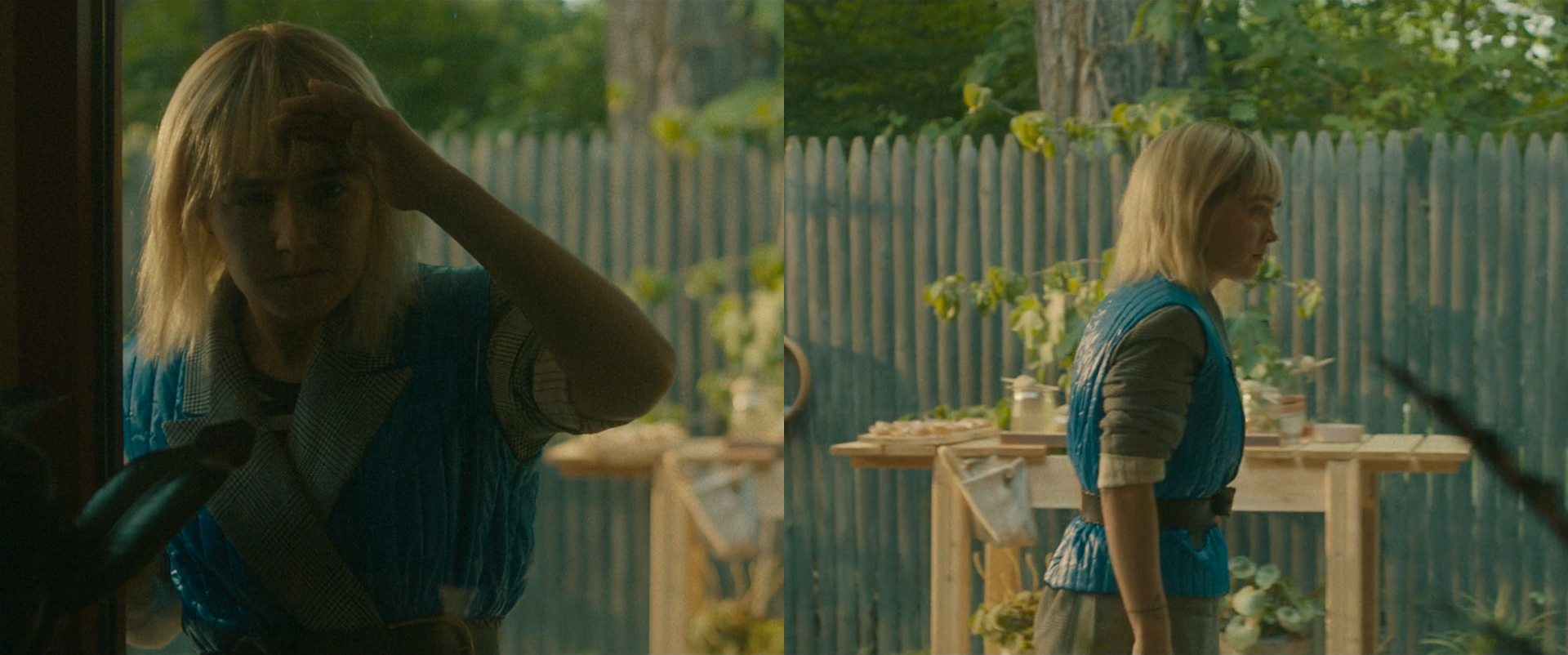
This scene is the first time we see Ada outside of the opening credits. She is wearing a cerulean blue channel quilted vest (in a seemingly synthetic jacket-weight material) layered over a grey micro-plaid blazer with the lapels sticking out. The blazer is cuffed above the elbow with a yellow and white plaid underlayer with a striped t-shirt underneath. Shown briefly in wide are sunshine yellow pants that are decidedly more fitted than the wide-legged trousers which will be discussed later. The blazer also acts as a skirt. The ensemble is belted. Boy, is it a look.
Ada’s outfit is simultaneously ugly and kind of alienating while also dead cool. It’s weird, but she’s pulling it off. It gives the air of someone who is young in their style, slightly edgy, and picking from second-hand. Ada is often seen in blazers and is one of the only character with pointed lapels. Noticeably, Ada’s sleeves are cuffed- this is a major trend throughout the styling. Noticeably, this blue is repeated throughout many of the present-day outfits (meaning non-flashbacks), albeit often more muted and considered blue.
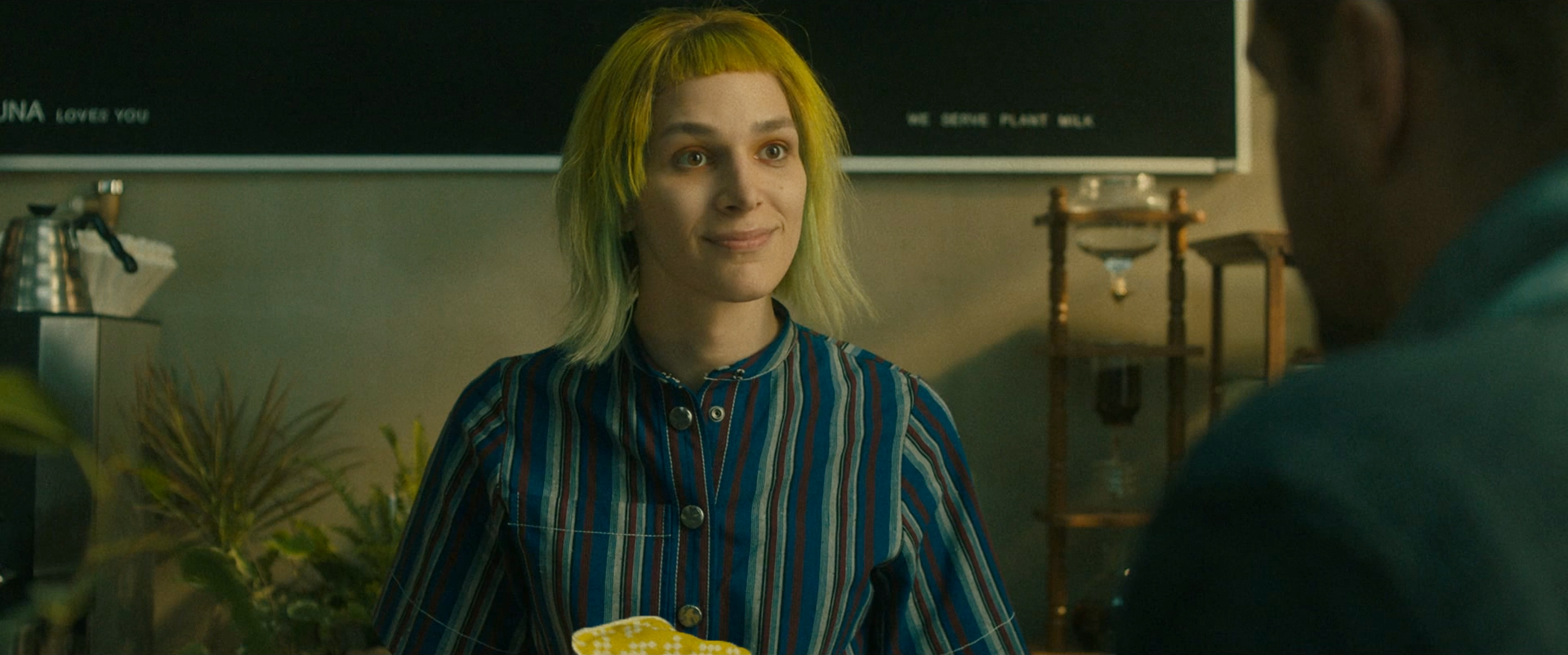
This scene of Ada’s barista coworker is short but gives great context into the hair trends Ada and Yang are following. Her dressing style is a bit more conventional, opting for the heritage/traditional textiles and the wide-sleeved silhouettes seen on other characters.
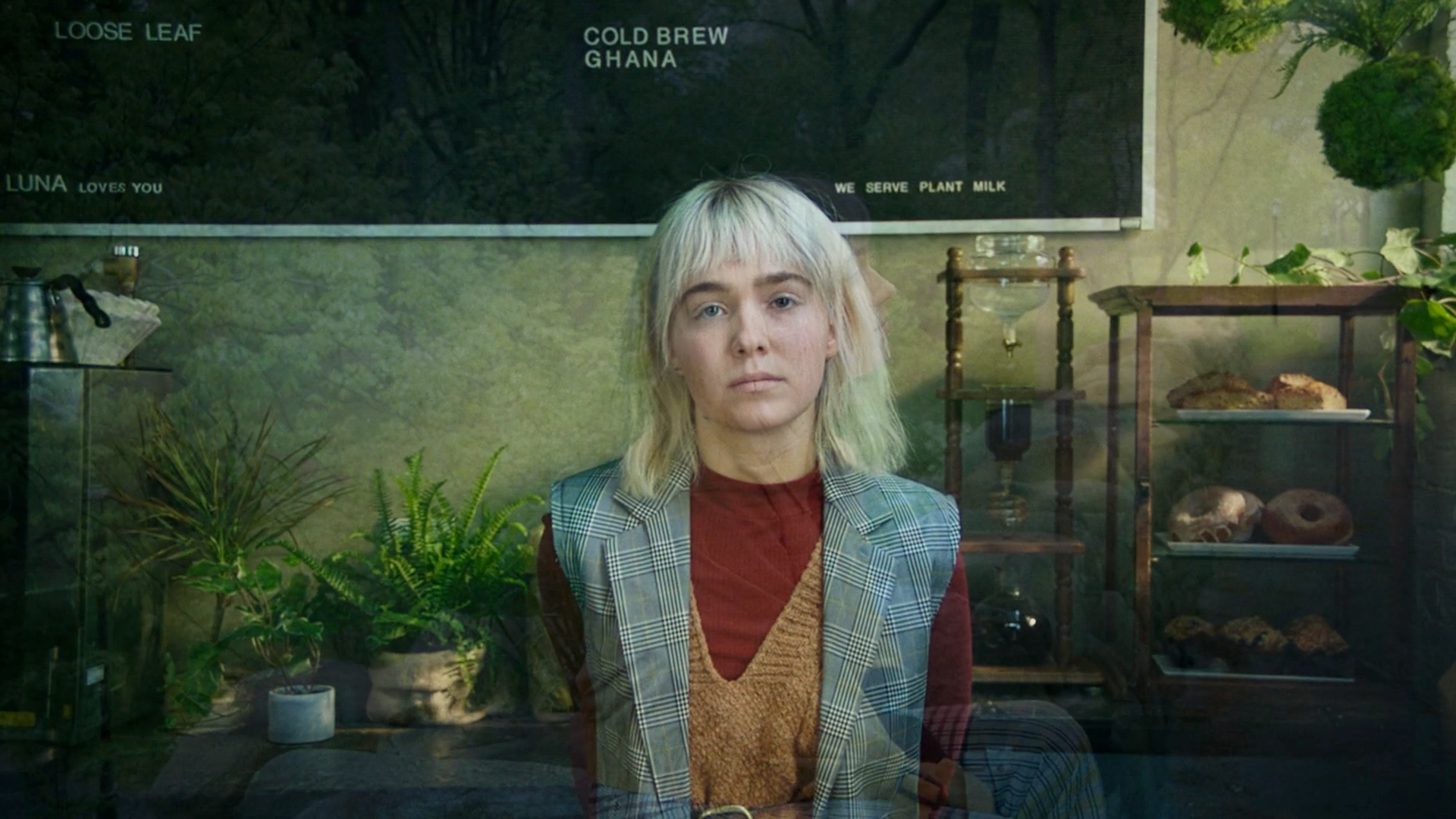
Another banger of an outfit. It stars a blazer that is similar, but not the same, as the first. This time, the blazer is sleeveless, unconventionally layered and belted with a low v-neck knitted sweater vest and a high collar, but not turtleneck, long sleeve maroon(ish) t-shirt. It fits her story of layered, unconventional dressing to a T.
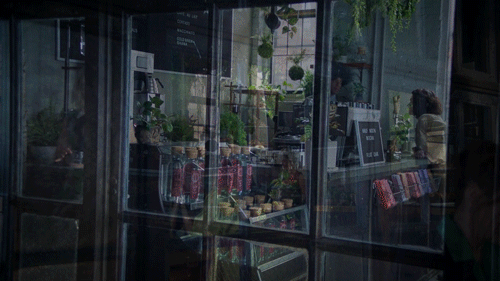
This outfit is so hard to capture, so here’s an animated gif. This is another example of Ada wearing a sleeveless blazer, this time in a tropical floral(?) print with black and white lapel, collar, and pocket flaps. Most likely paired with the same yellow pants as before.
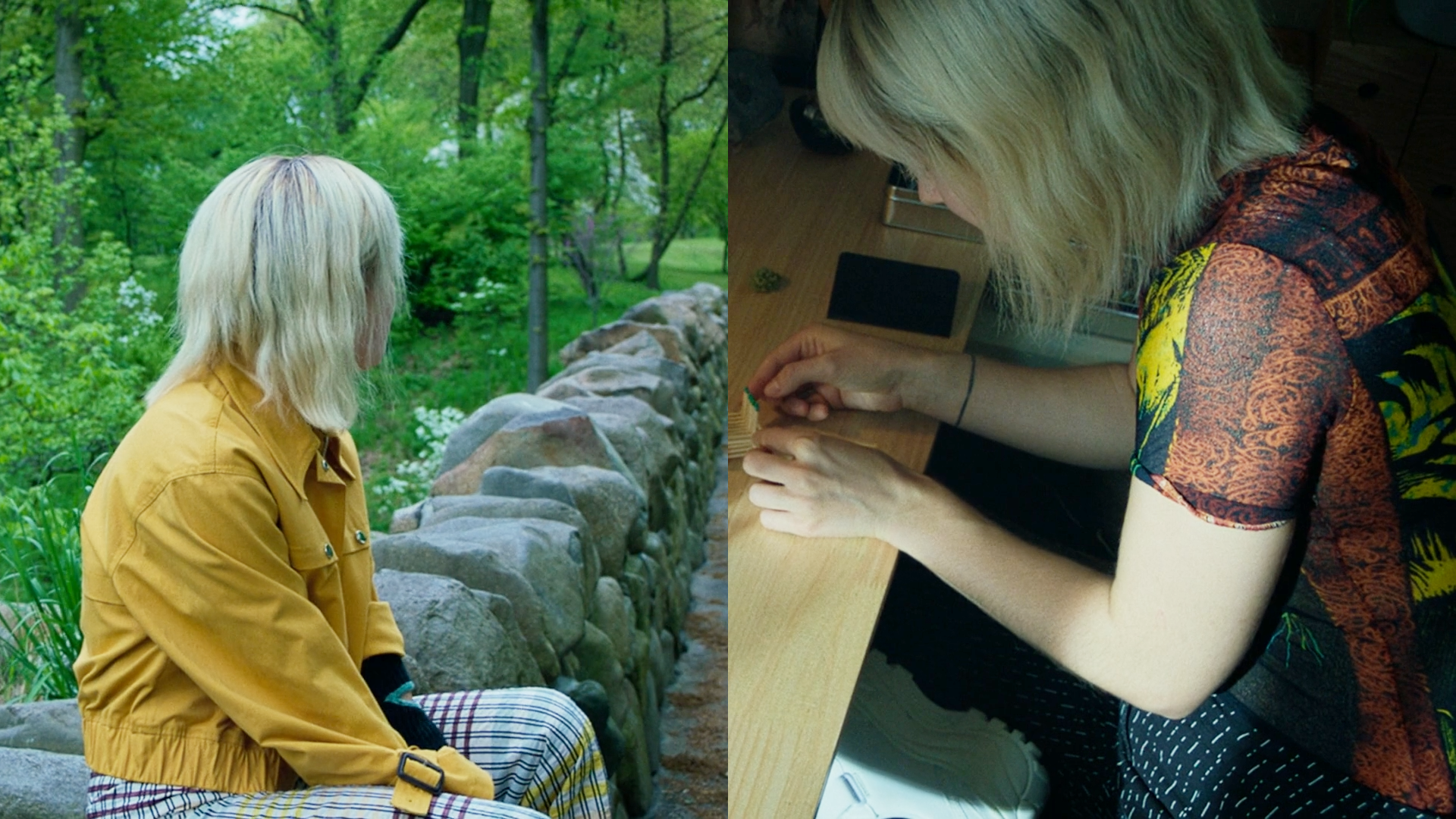 Ada’s Gen Z outfits.
Ada’s Gen Z outfits.
On the left, Ada is wearing a sunflower yellow denim/twill jacket with seersucker plaid pants in white, cranberry, yellow, light blue, and navy/black. Her left sleeve is cuffed, revealing a sweater or arm-warmer with an interesting robin’s egg blue cutout detail. On the right, she is wearing a graphic t-shirt that looks like an incredible 90s thrift score. The shirt is (half-heartedly) cuffed and paired with pants with a print reminiscent of Malian mudcloth/bogolan print filtered through Nordic minimalism (completely making this up in the absence of a more proper way to describe it).
Yang’s gaze captures Ada often, so she wears a lot of clothing in the film. She has a distinct style that is also the most expansive. The actress also played Portia on season 2 of The White Lotus- a character whose outfits were a lightning rod for criticism and praise (link: Vogue- Are Portia’s Outfits on The White Lotus Good or Bad?). I personally think that her White Lotus wardrobe is lightly poking fun at the chaotic fashion sense of Gen Z’s hipper factions. A generation whose dressing is impacted by COVID lockdowns, TikTok-baiting fashion vloggers, and hyper-individualism in place of more unifying youth subcultures- a lack that is due to ultra-fast trend cycles making it hard to grasp something before it goes out of style or cringe. These last two After Yang outfits would feel at home on Gen Z fashion vloggers, which I believe is intentional. Ada is a cipher of youth.
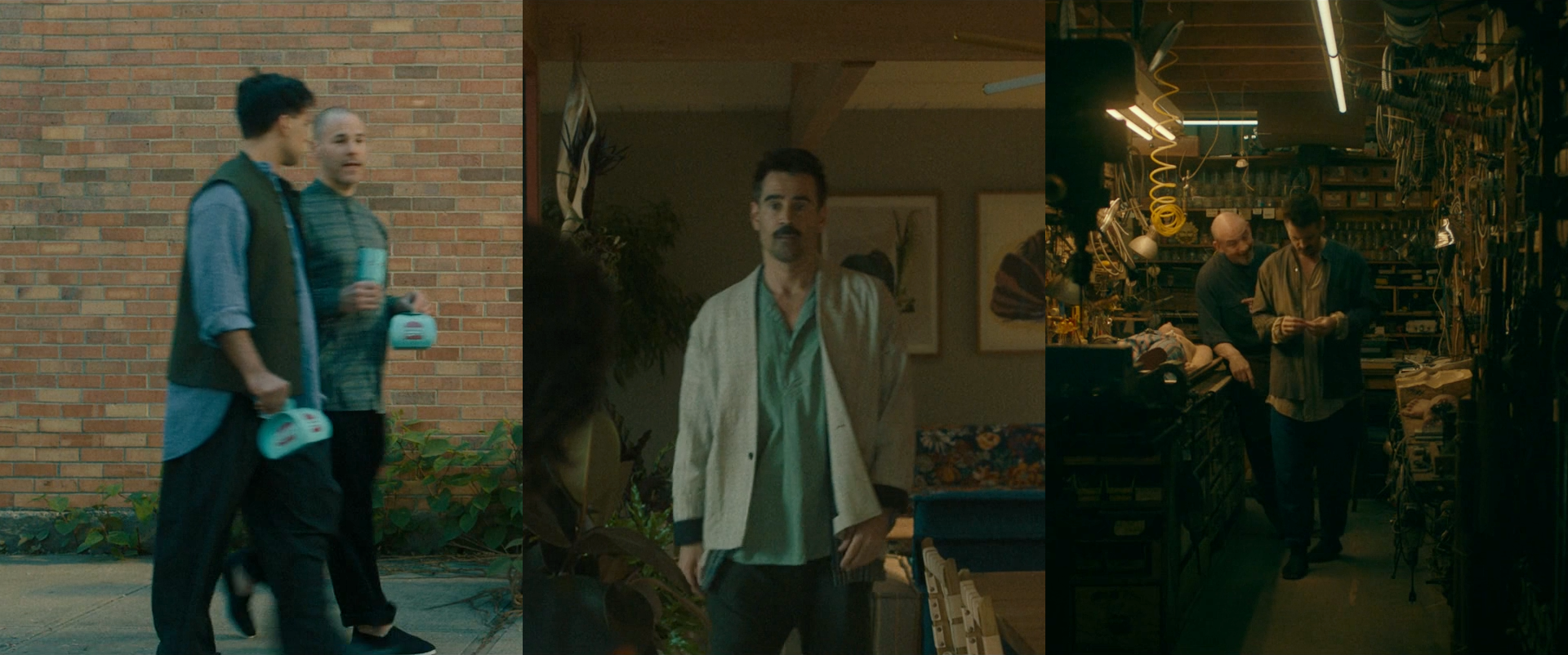
Opposite of Ada is Jake, the father figure of the family whose style I like to think of as a shabby Muji futurism. He dresses primarily in cottons and linen-like fabrics- often in earth and jewel tones. Typical details for Jake’s wardrobe include band collars, slightly oversized cropped jackets, and easy-wearing wide-legged trousers. The cut of the jackets seem to nod to contemporary interpretations of happi coats (link: Muji- “Roots of Tradition”). He would look hastily put together if it weren’t clearly a popular style in this universe. The left screenshot is of a background character in a similar style. The olive vest with the oversized denim button-up shirt and the exaggerated back flap* with the wide-legged navy trousers and simple shoes paint a picture of workwear comfort. I love this look- he looks like he shops at The Gap in the 2090s- I wouldn’t blink at a character wearing this in a Friends episode. Maybe. However, the exaggerated back flap is more than just a styling detail- consider that the length makes the garment resemble a modern kurta (link: GQ India- “How to wear a kurta in 5 different ways this festive season”). This garment feels like an effortless blend of the work shirt and kurta- done in a classically American denim.
*Note: the uneven bottom hem on button-up shirts is to make the shirts easily to tuck into pants. This does not serve that purpose whatsoever.
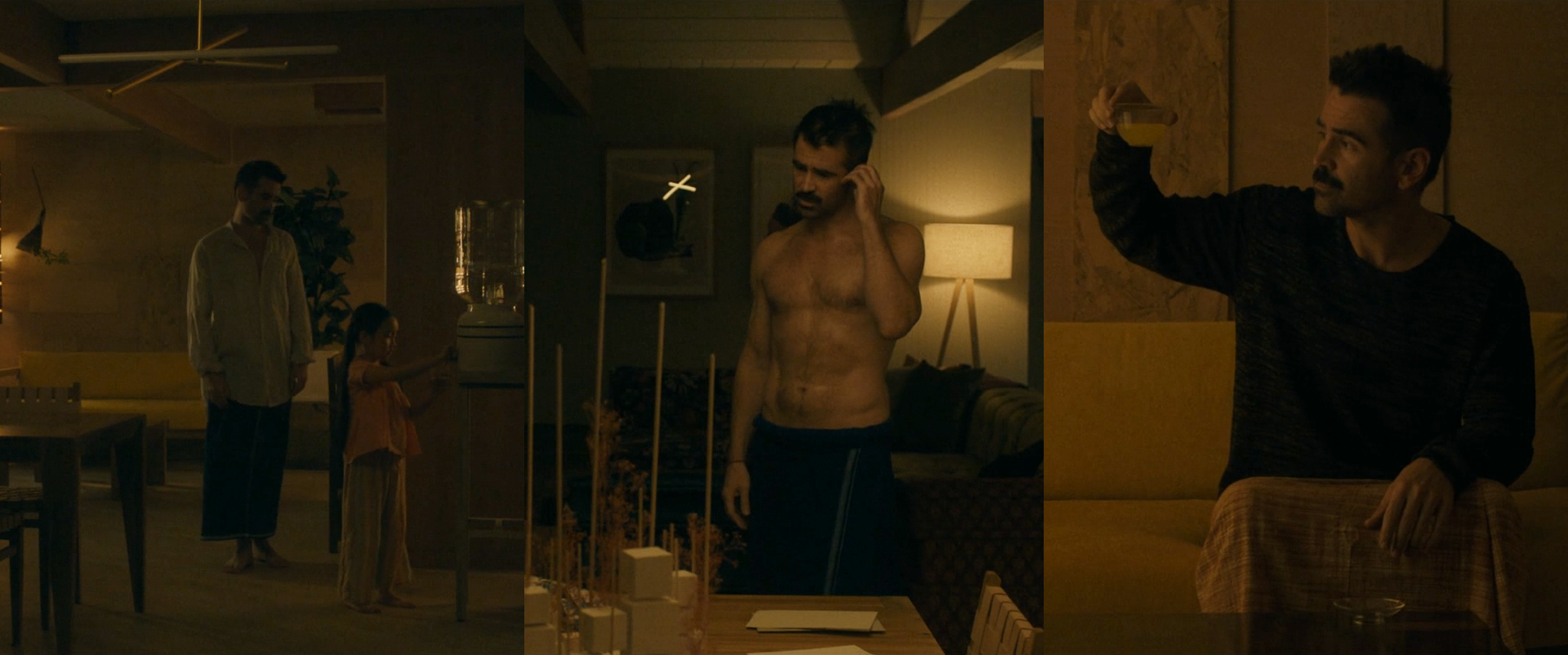
I would be remis if I didn’t point out that Jake regularly wears a maxi-length wrap skirt to bed. Actually, it’s more likely a lungi (link: Wikipedia), a sarong worn in India by men for this exact purpose. It is interesting to note that lungis are often (but not as a rule) plaid.
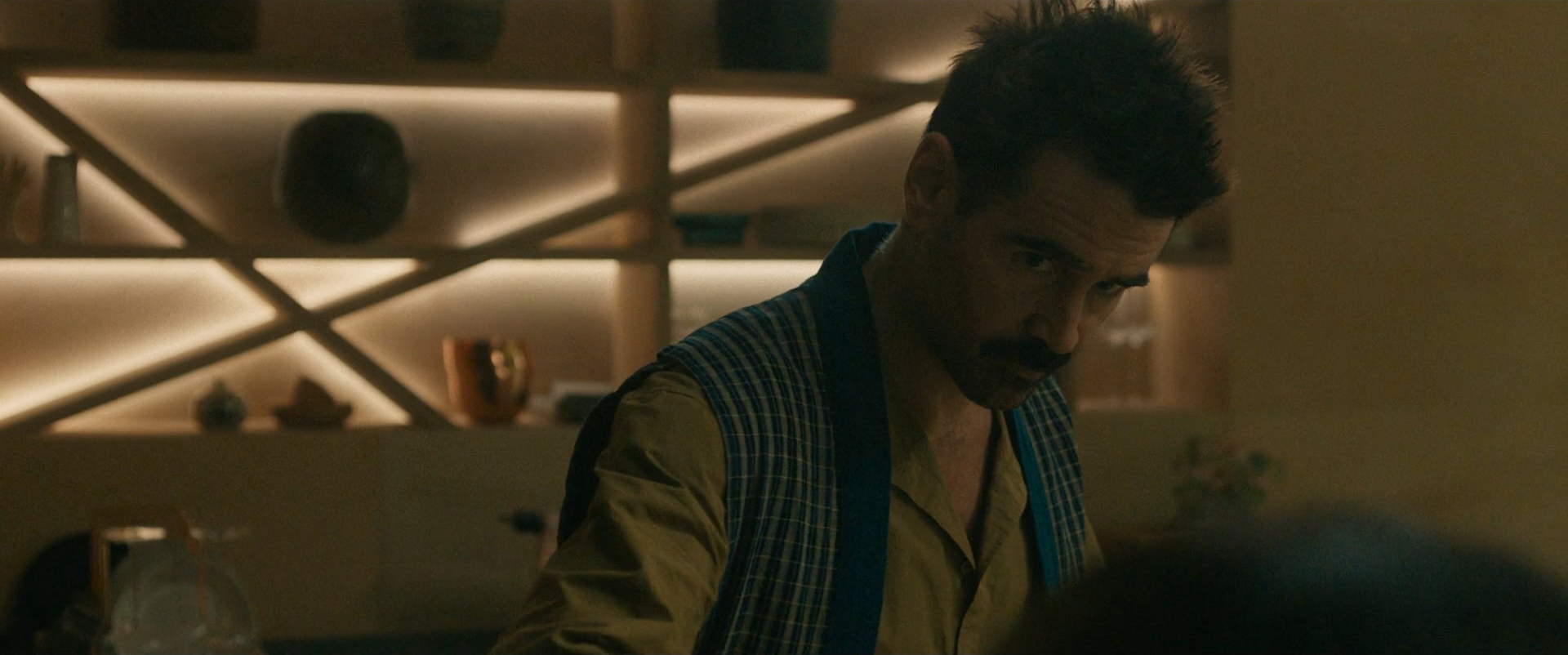
Jake wears a LOT of these band collar undershirts and they are are most always unbuttoned. This outfit is from a recent flashback where Jake prepares tea for Yang and talks about why he likes tea- it soaks up the terroir of its environment and feeds it back to you. Here, he wears a small plaid vest jacket with a teal (maybe cerulean in yellow lighting) shawl lapel that lies flat. We will return to plaid shortly.
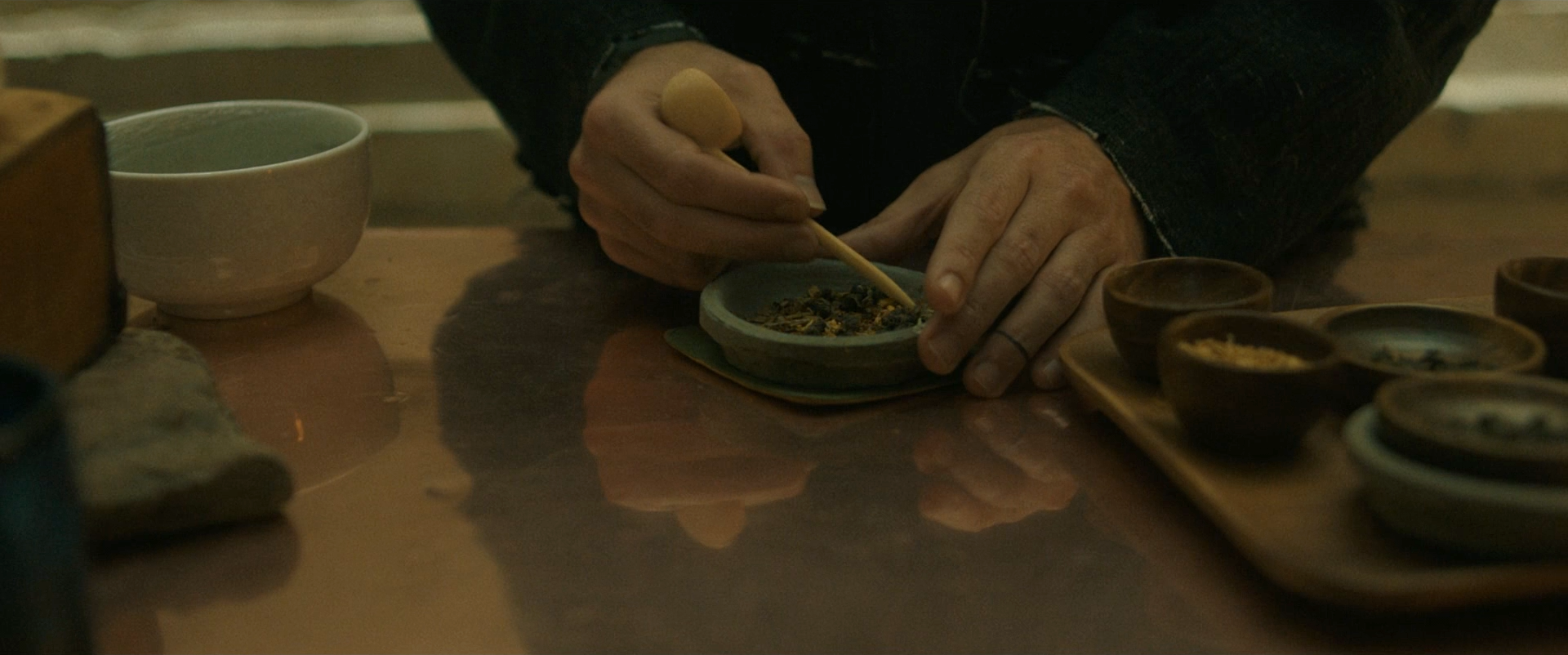
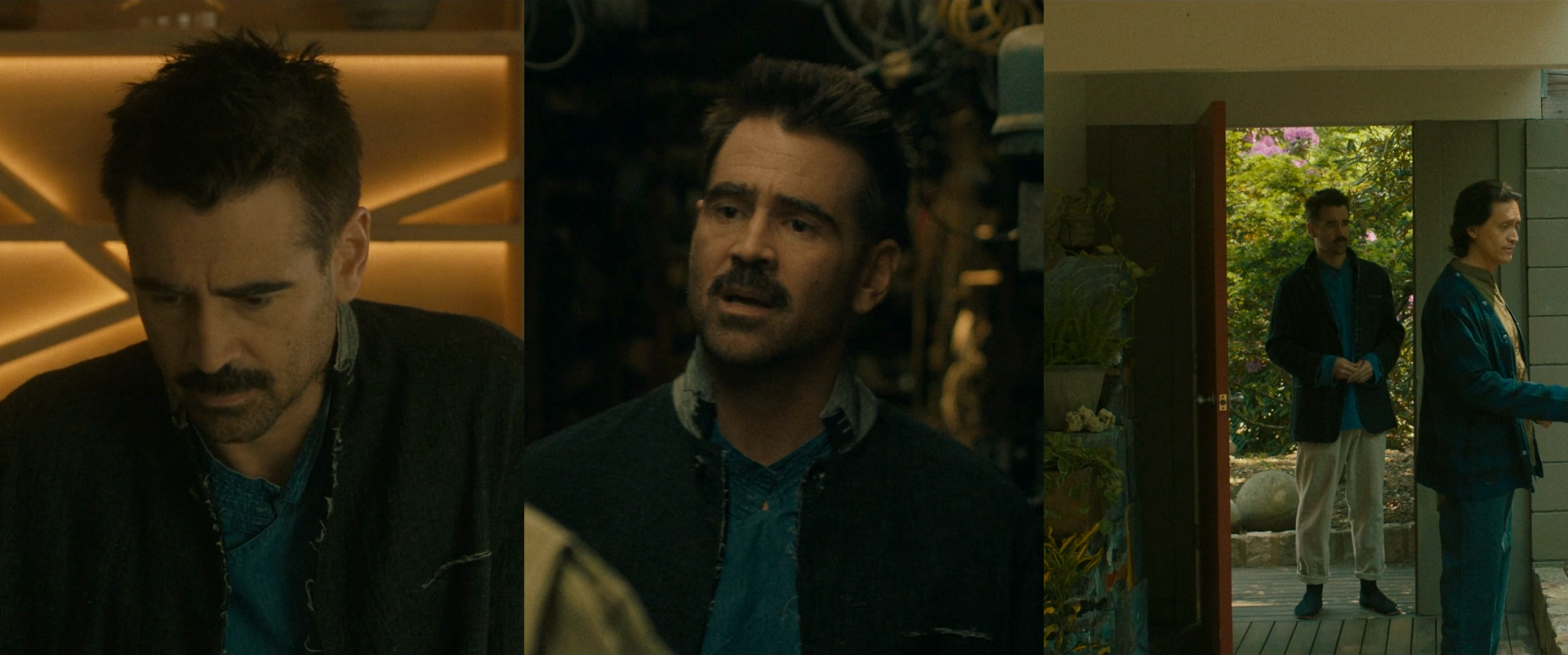
Jake’s raw edge denim jacket is his shabbiest piece. It features a literal slash pocket on the chest and a thick jersey knit collar in place of a ribbed knit. There are patches of denim on the front of the collar, hand-stitched and completely decorative, since the edges of the collar are not raw. The denim material is so light and appears to be chambray, but I’m more certain that it’s a stretch denim due to how the threads look along the raw edge. It is an amorphous piece of clothing worn over a denim shirt with an asymmetric front.
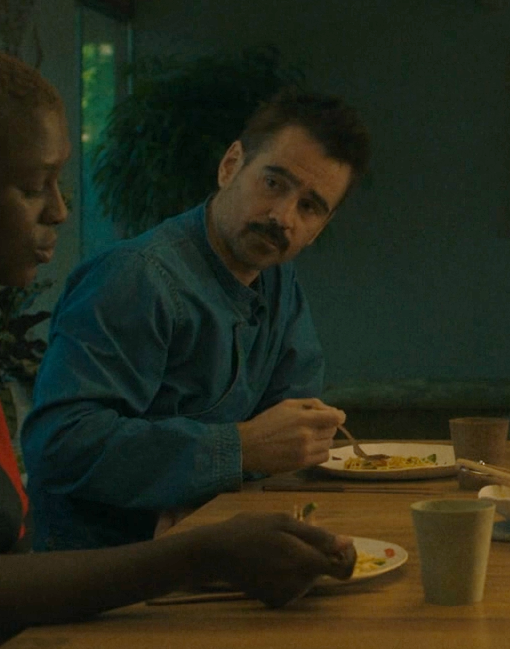
This is the best look at the front of the denim undershirt. The front creates a peak to the right and then plunges under the armhole curve. The band collar is more square and stitched flat in rows (which makes the collar more durable). This stabilizing stitching is also seen on the arm band and is a nice detail that sells the realism of the garment. Strangely, there are no visible buttons which lifts the garment from workwear to something a bit more sophisticated. The sleeve is slightly wide, which matches the general fit of his garments.
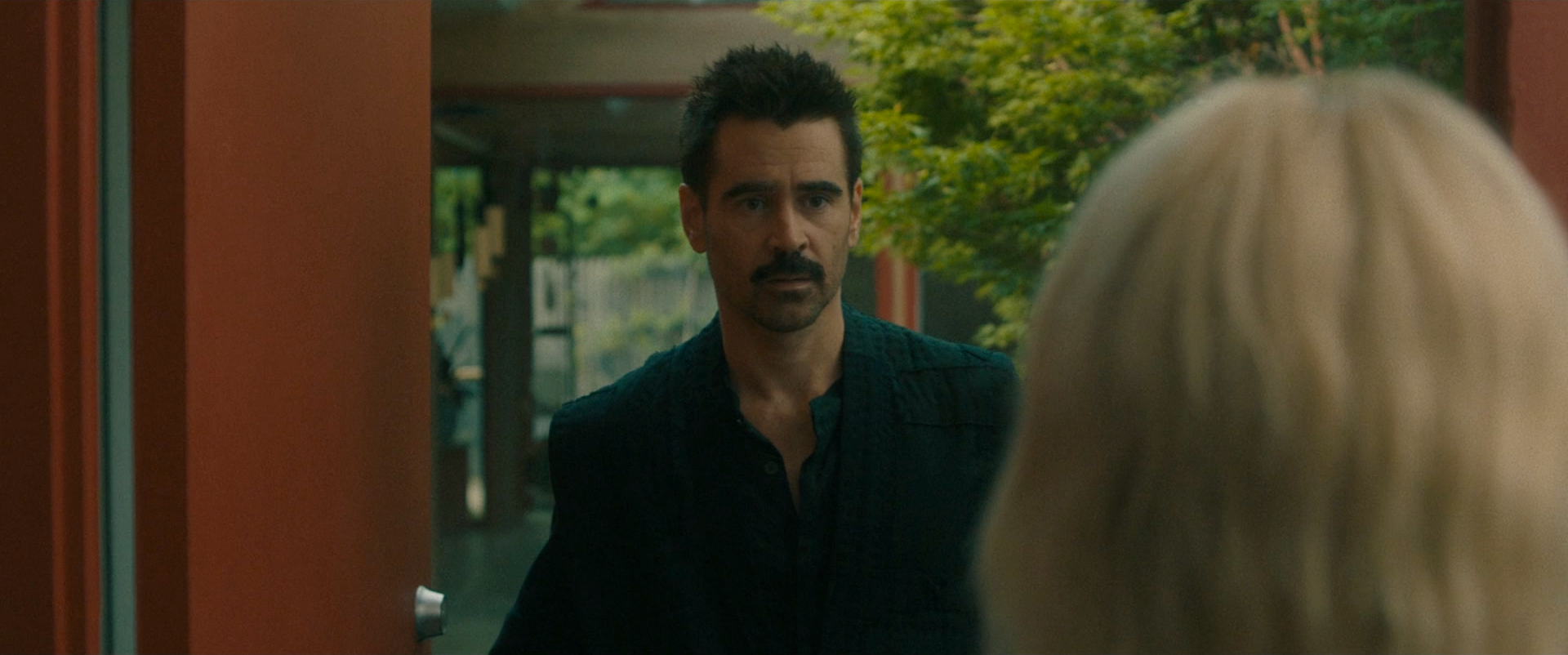
When Jake meets Ada for the first time, Jake is wearing a black, deceptively simple gauzey cotton vest jacket that is patchwork and rough in spots, almost a boro style textile (link: High Snobiety- “How Traditional Japanese Boro Textiles Paved The Way For Sustainable Fashion”).
So why is a liberal white dude wearing so many Asian-inspired garments? Well, let’s look to our recent past. I remember during the Iraq war, it became a trend among young, more anti-war/lefty hipsters to wear keffiyehs as scarves. Vampire weekend even name-checked the garment in one of their songs (link: Youtube: Vampire Weekend – “Campus” lyrics). Jake and his generation feel remorse and guilt for the war; a guilt that transforms into cultural absorption and appropriation.
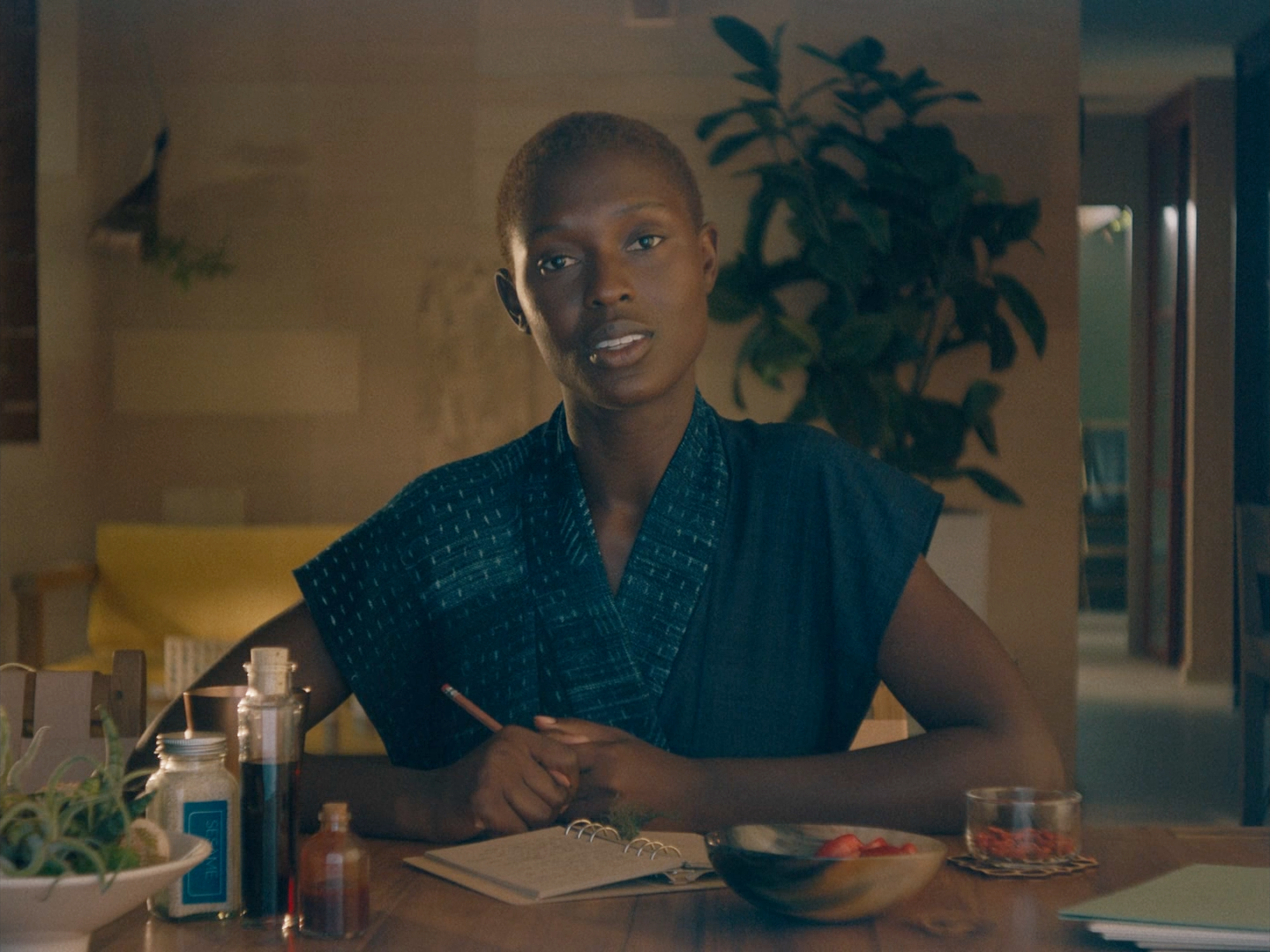
Kyra is the matriarch of the family and the assumed breadwinner of the family. She is much more put together than her husband, Jake.
Here, on a video call, she is wearing her most structured garment. It is an indigo-dyed print asymmetrically mixed with a solid indigo dye application sewn into a short sleeve dress or tunic with general kimono details (large sleeves, wrap opening, and belted sash). I find Kyra’s costuming to be the most mature and least exciting. There’s a lot of loose and drapey- possibly because the role was re-cast days before shooting (link: Youtube- Cast Q&A…). That said, she wears the most beautiful textiles in the film.
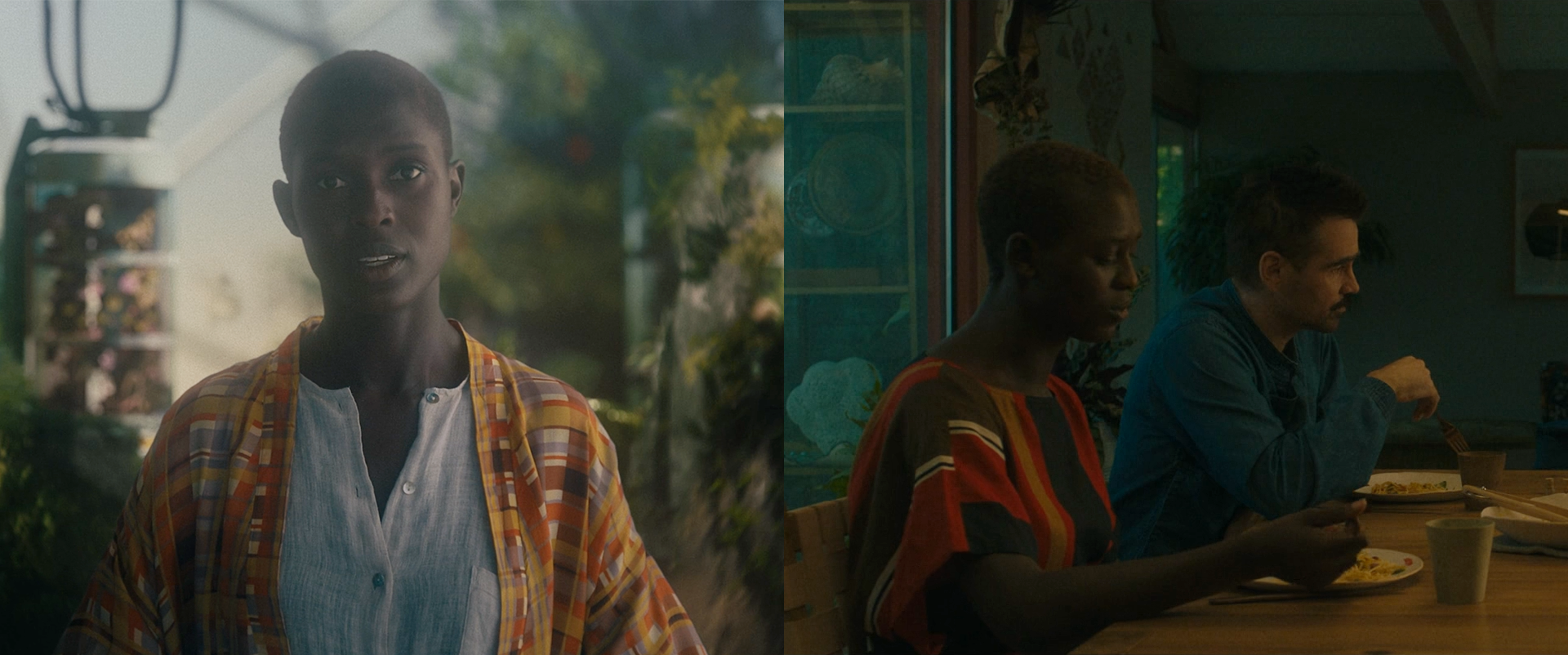
On the left, Kyra is wearing a shawl jacket in a complex, earth-tone madras print on top of a loose-weave, collarless button-up shirt. The madras print is skipped and piecey, looking almost like patchwork madras, which is a popular way make the textile. Madras is an interesting fabric because it originated in southern India and was exported worldwide (link Marasmim Blog-“A Humble Origin & Fascinating Stories Of Fashionable Madras Checks”. After Yang’s use of plaids is intentional. Plaid is a universal print due to mechanics of weaving. It can also be very specific to the origin of creation and the fashion of the moment. This means that plaid can read as in or out of style with just a small shift in color. In this way, Plaid is used to ground the fabric on earth, present multiculturally, and code the wardrobe as slightly out-of-step with present day fashion. All while keeping it palatable.
On the right is just a simple striped blouse in a really elegant colorway. This garment feels the most like it could be present-day RTW.
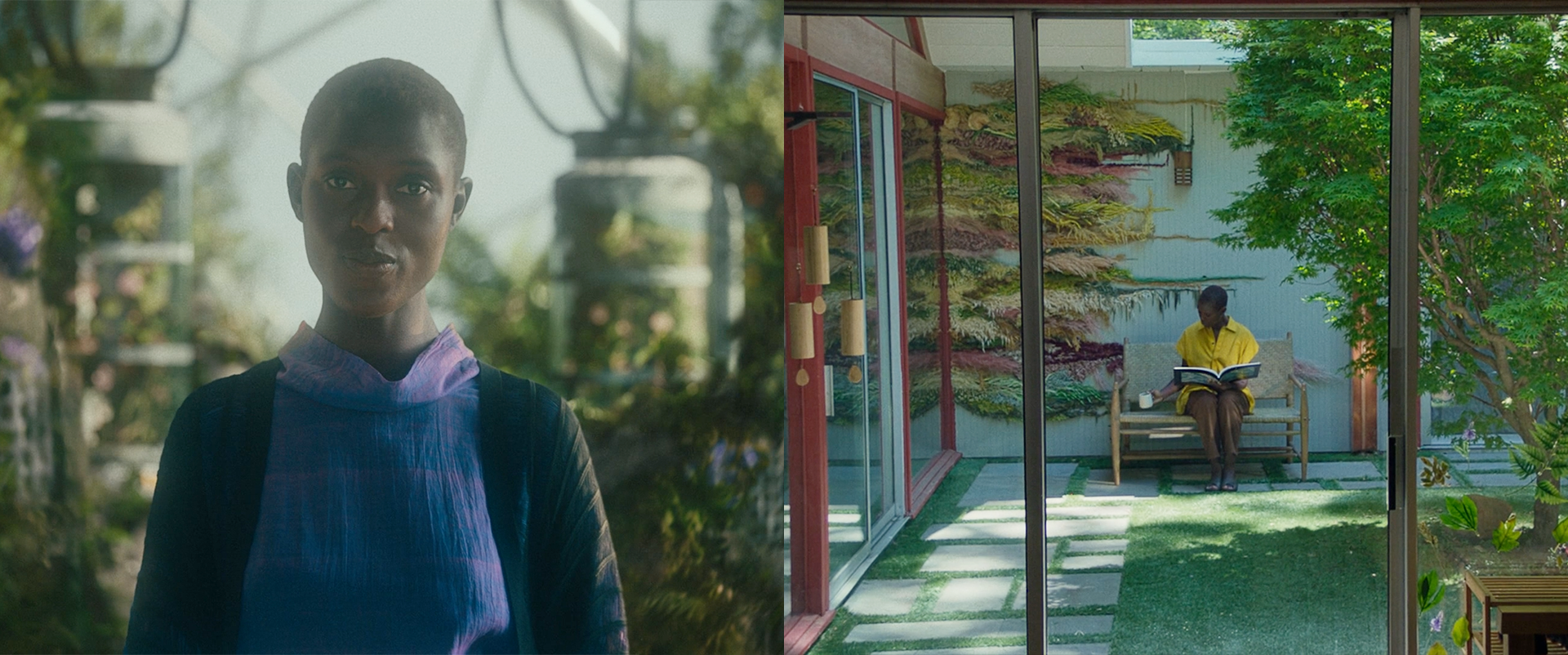
On the left, Kyra wears what I can only describe as a variegated, gradient woven fabric. It’s on the edge of being a plaid (up and down stripes), but isn’t. I also wouldn’t be surprised if this was a button-up worn backwards- check the unusual high collar. The shawl looks like a 2×10 rib knit but is probably a woven material, which gives it a unique, lined texture that pairs nicely with the lavender purple and cerulean (almost pushing teal) blue top.
On the right is Kyra preserved in a lovely moment by Yang’s memory. Not to be distracted by the incredible garden, she wears a sunshine yellow buttoned wrap top with wide sleeves (similar to the sleeves of the first example). Paired with brown wide-leg pants and open-toed mule shoes.
Kyra’s clothing contrast nicely to Jake’s. Her wardrobe is much more expressive while maintaining an orderliness.
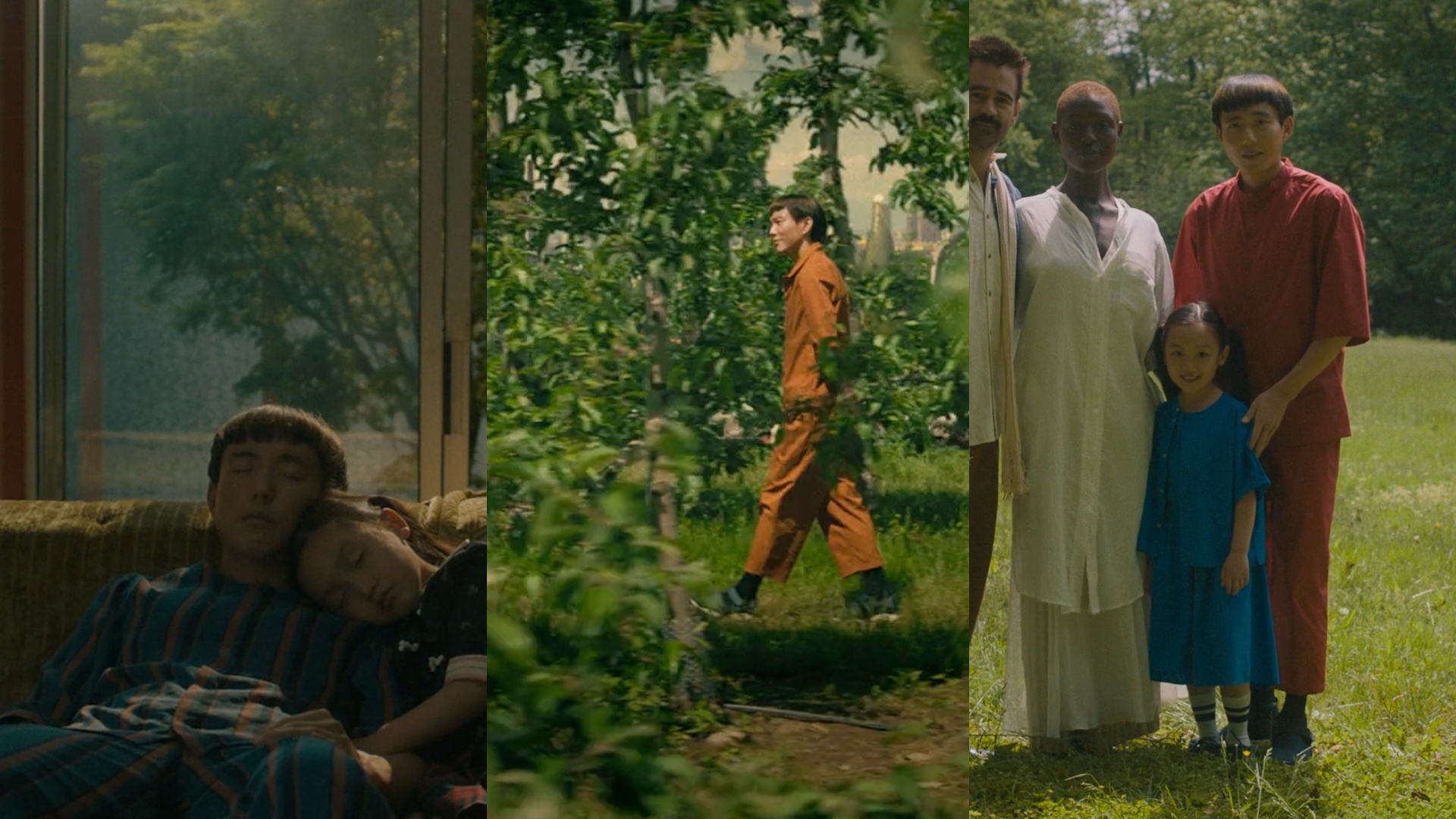
Yang is presented as a mystery. He is, at the beginning of the plot, a fleeting memory of a family member and a deceased technosapien. The simple matching sets play up assumptions of his utilitarian nature.
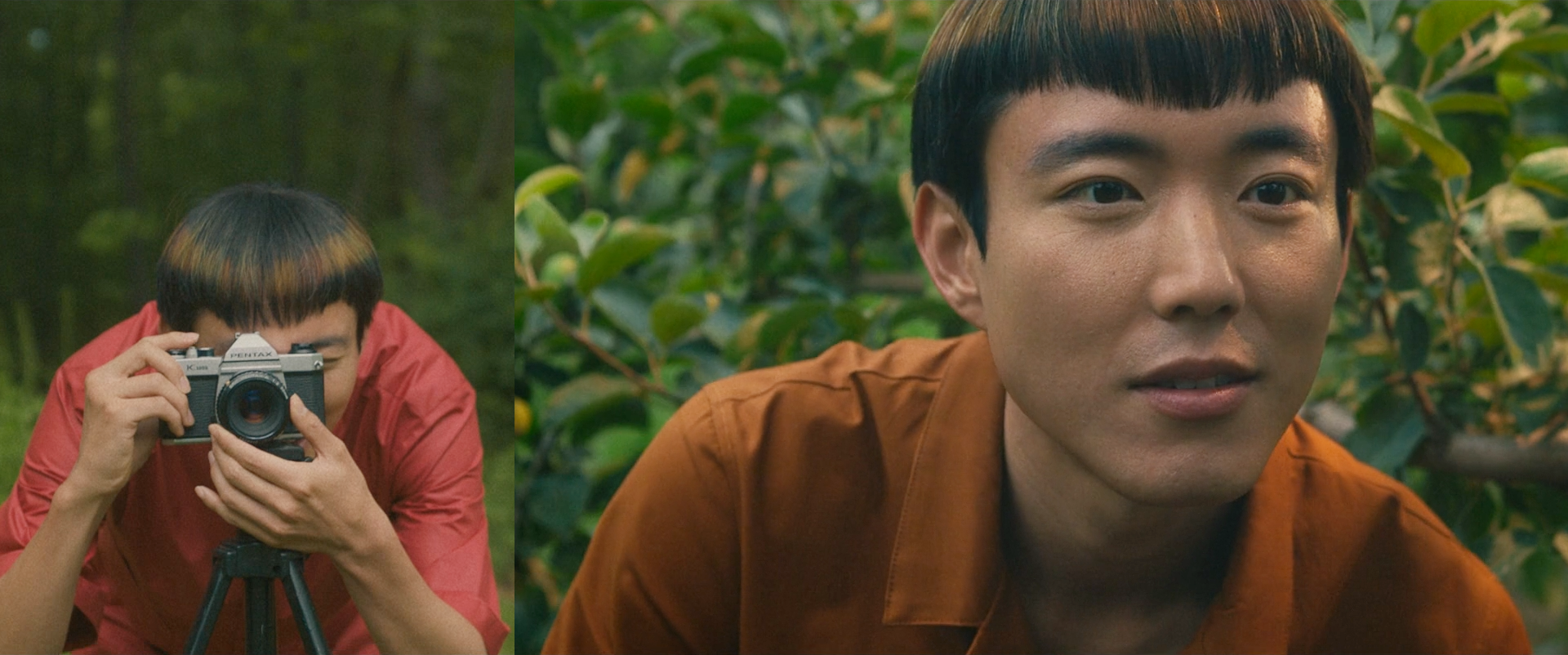
Yang’s hair is colored and cut in a manner similar to the two young adults (Ada and Faye). The cut is undeniably a Spock cut (micro-bangs being the important trend), with a crown of holographic effect dye (link: Tik Tok search for “holographic hair”). Definitely a cool-kid hairstyle that could fit into the present- see Karen O’s hair at the end of her new music video (link: Youtube- Yeah Yeah Yeahs- Spitting Off The Edge of the World).
On the right is a closeup of Yang’s rust orange matching set shirt and pants. This is Yang’s true introduction- the first time we see him speak and interact. It is an incredibly tender moment. The pants are wide legged and cropped, but never styled with cuffing. They do more to push him out from the scenery and fill his frames with color contrast than to convey information about his identity. In fact, at this point, the lack of identity is his main characteristic. What we get from this scene is that Yang’s view of the world is profound and reserved.
And then there’s how Yang sees himself.
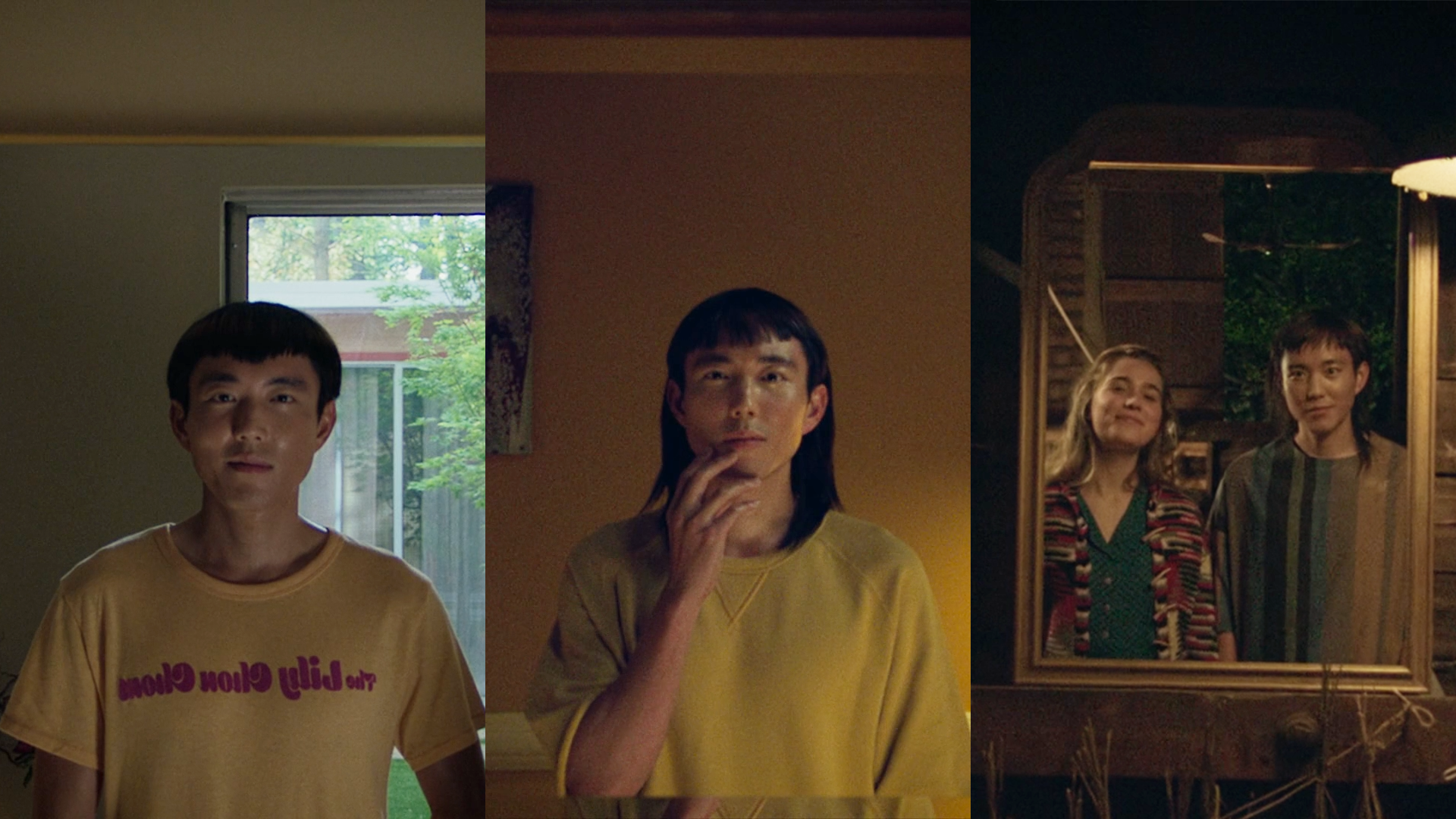
On the left, Yang wears a band t-shirt he presumably got at the show he went to with Ada. (Sidenote: Mitski is actually covering a song from fictional artist Lily Chou-Chou [link: Wikipedia]).
In the middle, Yang wears a yellow, short sleeve raglan sweatshirt (similar to the navy one he wears in the scene where Jake prepares tea for him). His hair is a long mullet. Seeing him in a different hairstyle is a shock because it raises questions of his own self-perception and identity.
On the right is Yang wearing an almost shapeless tunic top with wide, half sleeves in muddy earthtone vertical stripes. This is a fascinating insight into who Yang was years ago, when he was friends with Ada’s Great Aunt (also named Ada, who I will refer to as Ada-GA). Yang’s wardrobe with Ada-GA is still comfortable and utilitarian, not denying his technosapien-hood, but fitting in with Ada-GA’s style. Utilitarian, but not soulless.
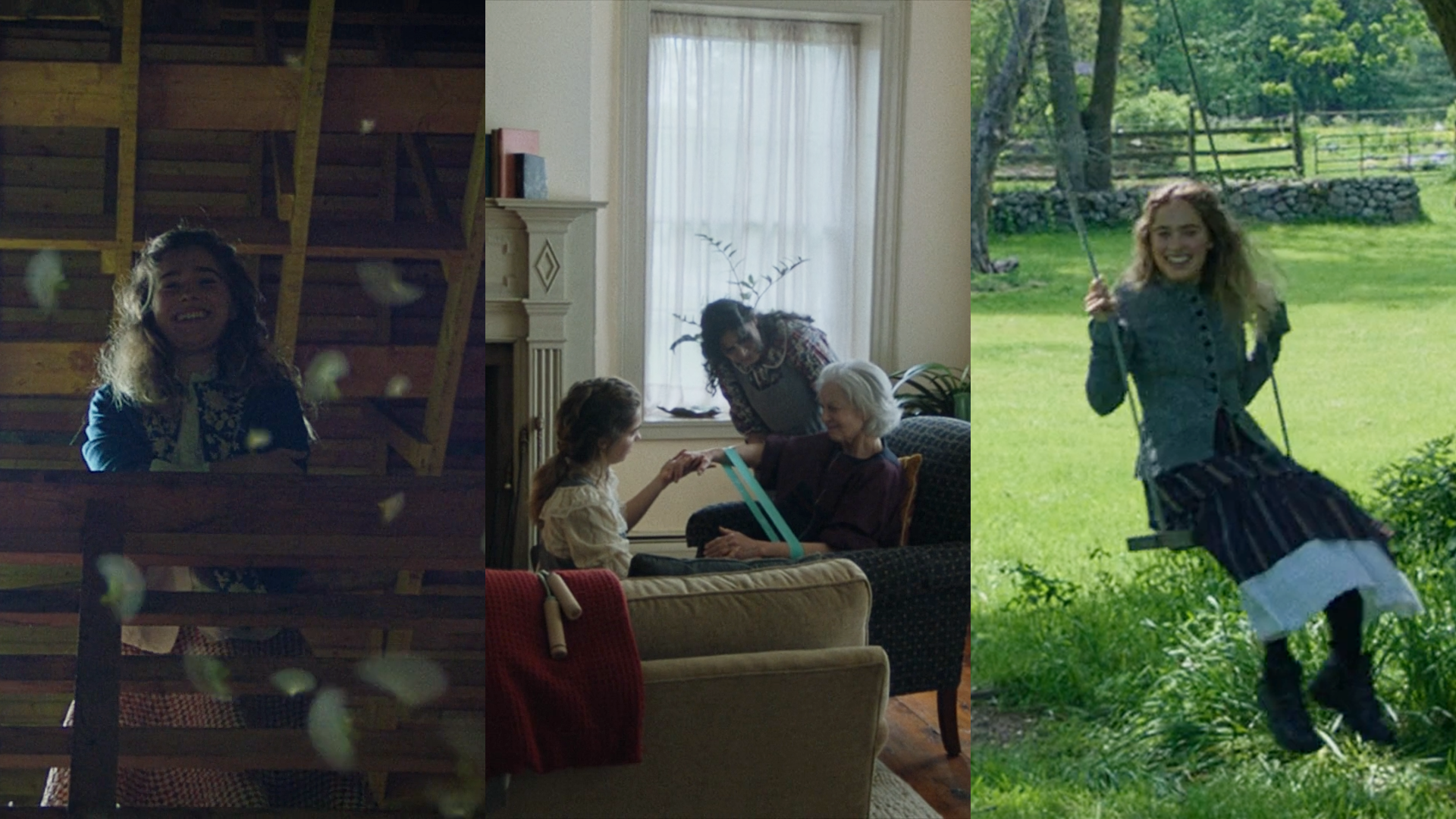
Ada-GA lived a more rural life, at least 1 generation prior. The fashion in these flashbacks reflect that shift. Like the other young people, her style is more cobbled together and expressive.
On the left, Ada-GA wears an embroidered blue cardigan over a white button-down blouse. Under that is a seersucker gingham a-line skirt that is at least knee length. The key to Ada-GA’s style is vertical layering and turn-of-the-19th century pieces.
In the middle, she is wearing a white lace gunne sax or Edwardian dress that could either be for the prairie or bridal. What’s important about this frame is it shows her physical therapist co-worker in a similarly historical silhouette, establishing it as the style du jour.
On the right, she wears a fitted greyish-blueish riding coat, a black and earth-tone striped ankle-length dress with a layered lace skirt at the bottom, mimicking an underskirt. Paired with boots, it is an interesting hodgepodge of turn-of-the-century styling that mirrors the post-modern sense of dress seen in the film. But we must remember that these outfits were produced (I doubt regular people were wearing clothing that old so casually) and worn during wartime. The outfits could represent a possible yearning for a simpler and more peaceful time. They could also represent a yearning for a time of racial homogeneity. Not that I believe Ada-GA is consciously dressing for white supremacy- this is just the nature of trend analysis and how trends of dress can represent the unconscious anxieties and aspirations of a time and people. Assembled as the outfits are, they represent a misunderstanding of the roots of America or even a thumb-in-the-face of traditionalism. Unclear, but fascinating to think about. After Yang understands that future fashion is going to constantly look towards the past to create something new.
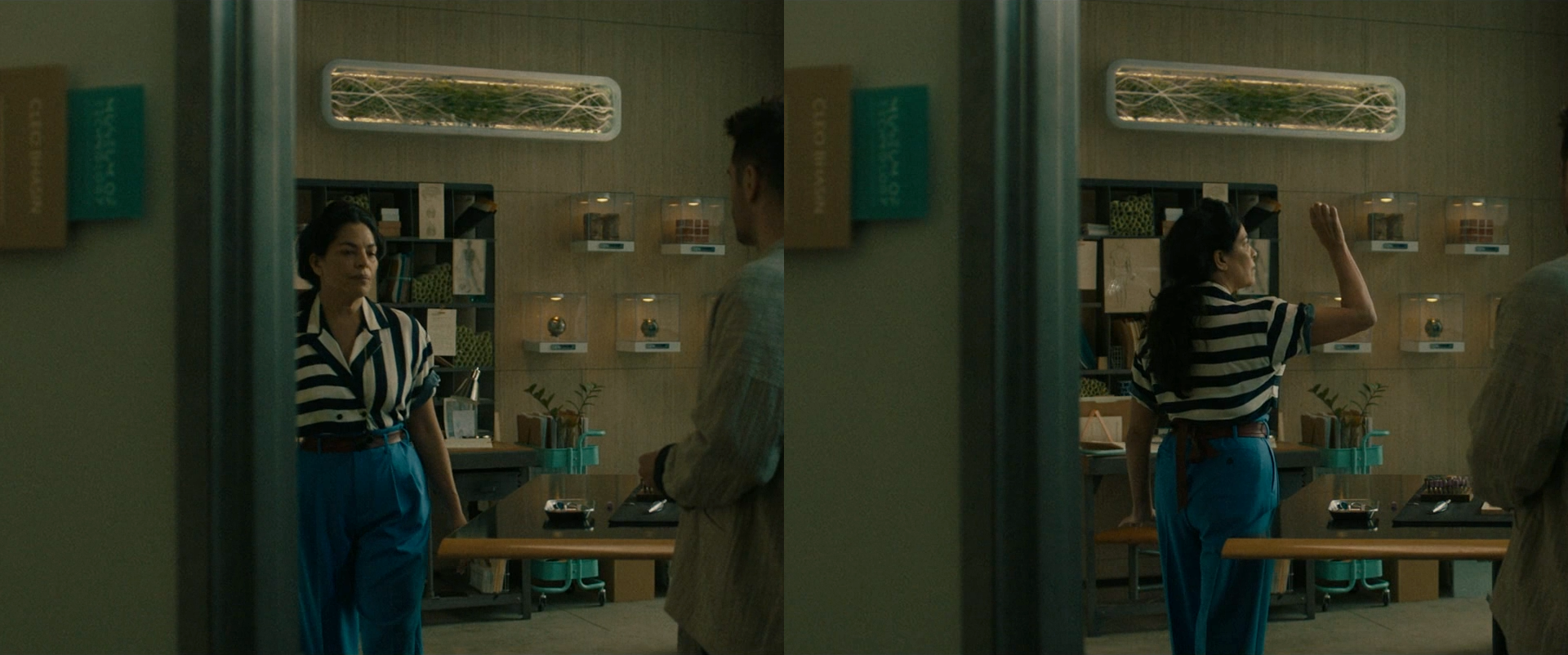
I have very little to add except that it’s an exceptional outfit and tailored so well. Cleo, the museum director, is wearing a black and white stripe blouse with the left front panel cut at 90 degrees to break up the stripes. The sleeves are wide and cuffed, keeping to the general style. The cerulean blue trousers are also wide-legged, cuffed, and cropped. The brown belt holds a brown scarf in the back. This is a great example of the character keeping to smart trends in workwear, yet shows that she is aligned to the more forward-thinking style of dress of the younger characters.
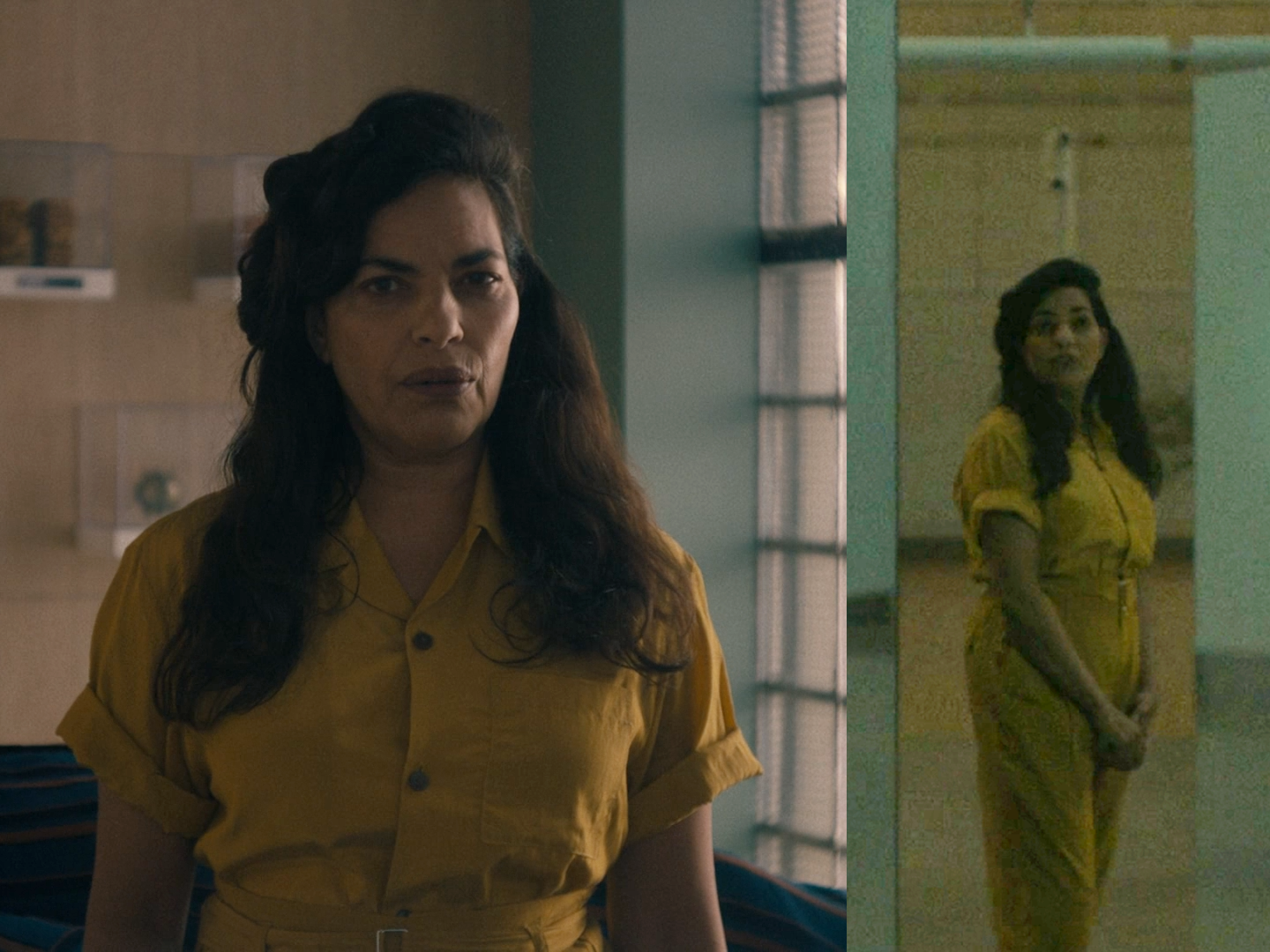
Like, eat your heart out, Big Bud Press.
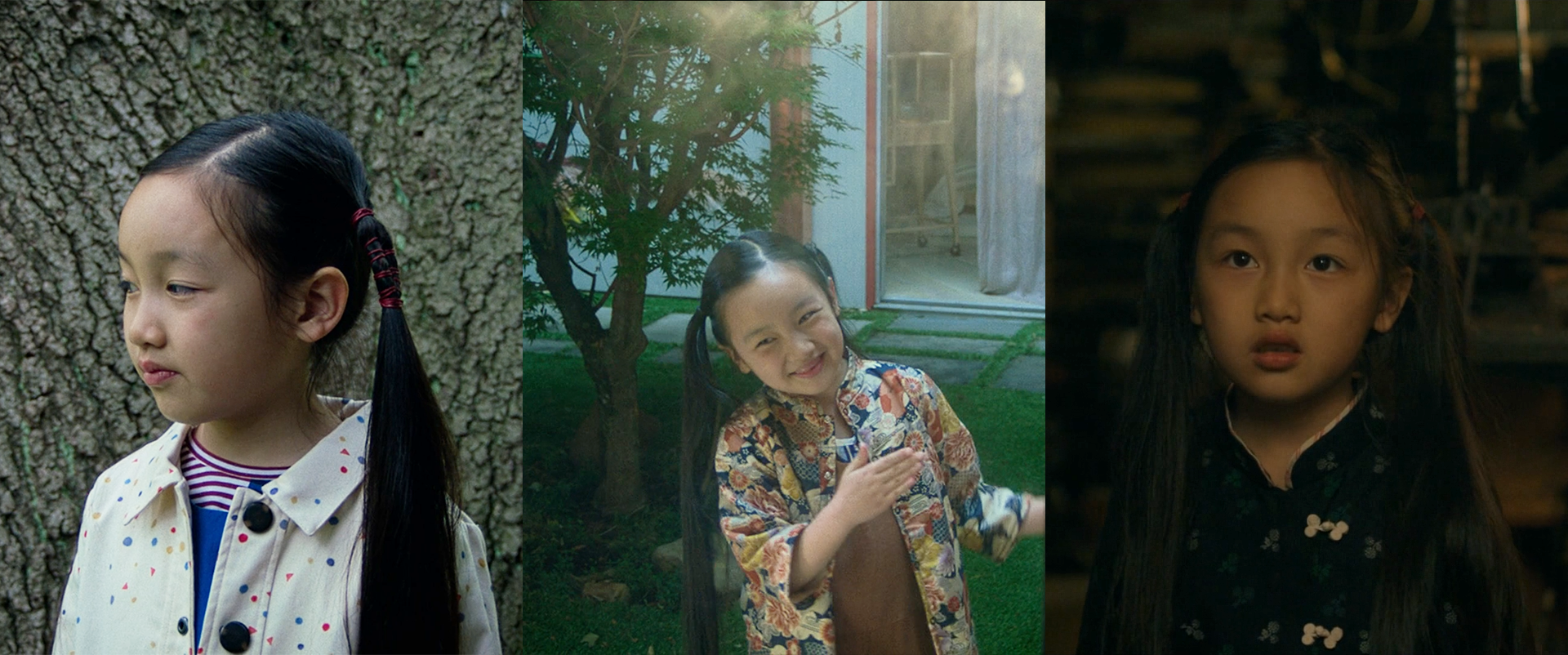
There is little to say about Mika’s wardrobe that hasn’t already been covered. She wears a lot of items that could be purchased today.
On the left is my favorite outfit- primary color speckle shapes on a white denim or twill coat. It is layered similarly to the middle photo with a solid color dress over a t-shirt. In the middle photo, she’s wearing a coat with what Google tells me is a (possibly turn of the century) floral pattern created for kimonos.
On the right, she wears what is possibly be a school uniform- a coat-length qipao or cheongsam paired with an off-screen red and navy plaid, pleated skirt.
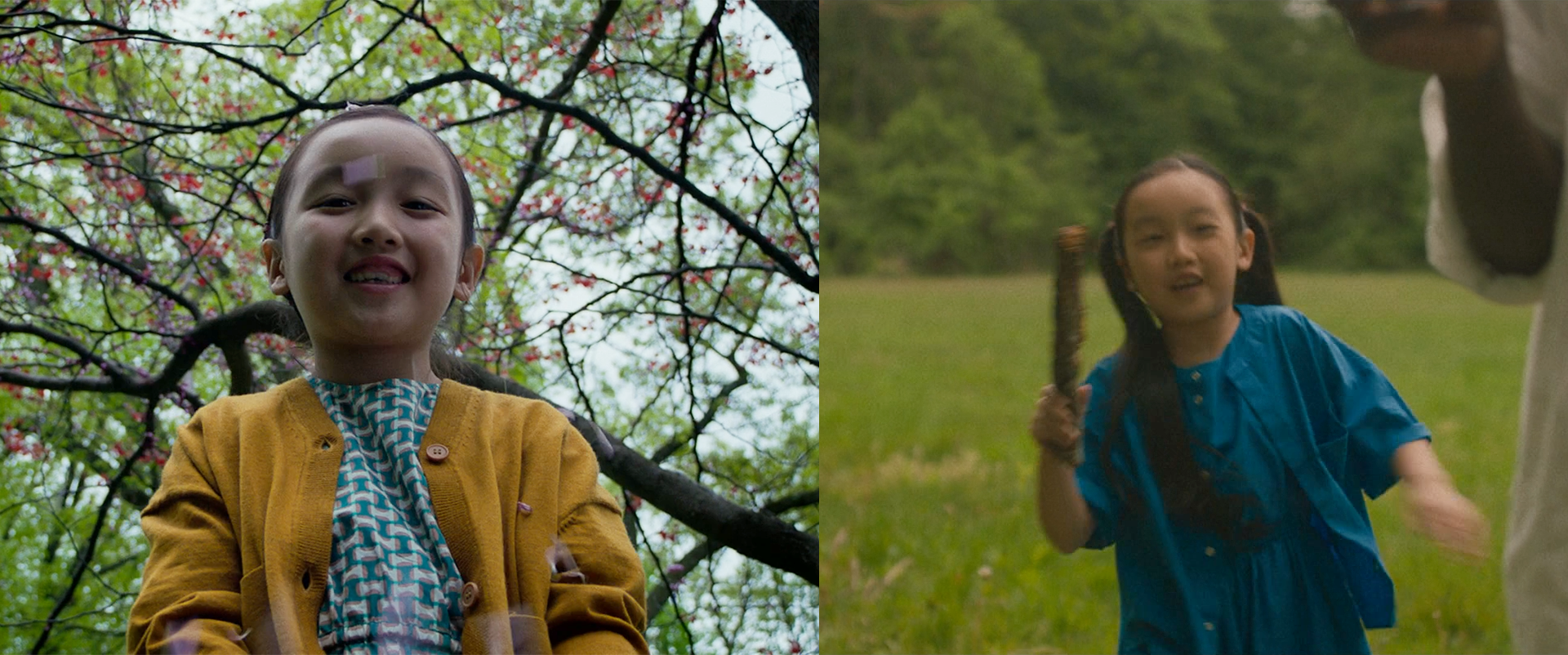
I sew for the little ones in my life and I find Mika’s clothes to be too cute. On the left, she wears a mustard cardigan and a gathered dress with a mid-century dusty pink and emerald green print.
On the right, she wears an ensemble that is between the color teal and navy (a popular color choice). It is a woven button up with a band collar and wide half-sleeves over a simple gathered dress. It is notable because of how similar it is to how Yang, her big brother dresses (heartwarming).
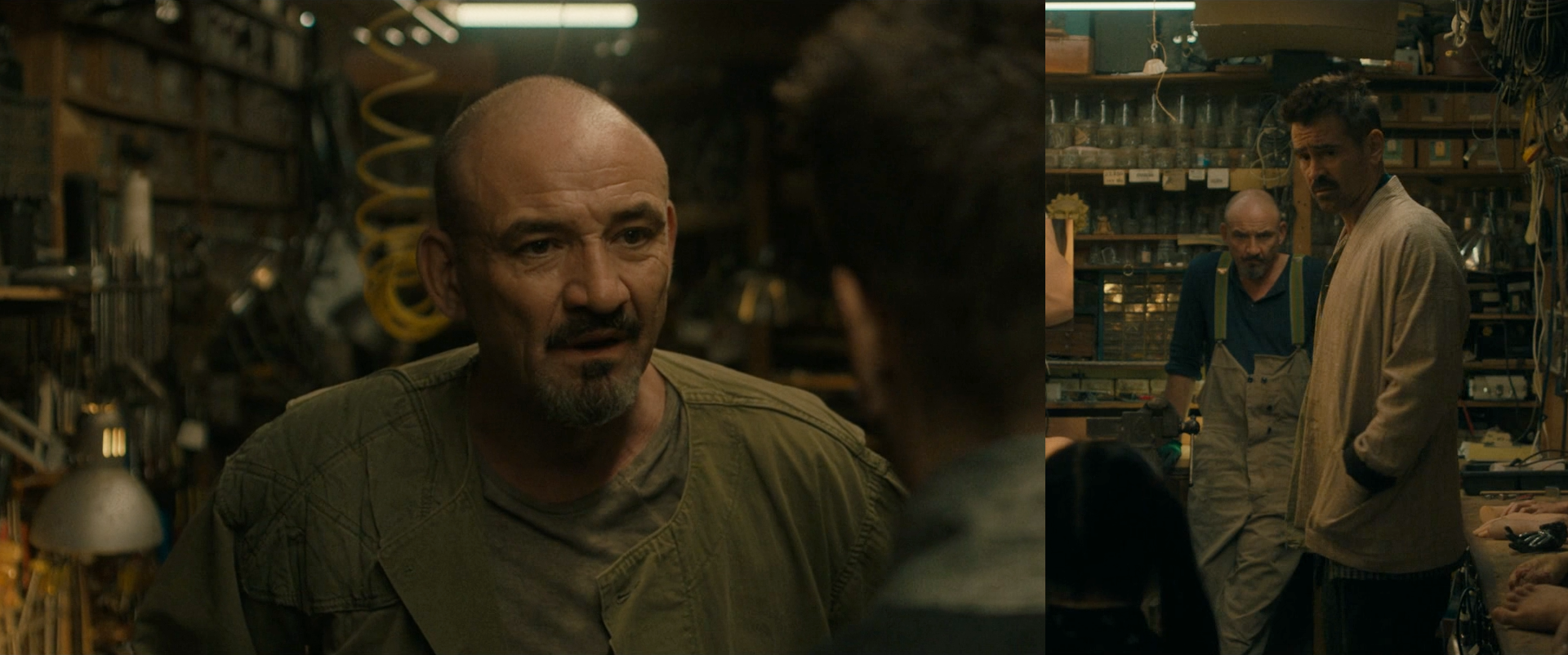
On the left, Russ wears a drab olive jacket/over shirt with asymmetrical shoulder stitching. It is collarless and has a button placket that is flipped over, but is not a lapel. To the right is a pair of overalls in the same color and material. The overalls are unique in that the crotch zipper is buttoned all the way to the top. It’s an innovative and utilitarian detail. These garments look like they came from an army surplus store. And from what we know about Russ, they may even be leftovers from his own time in the war. Russ’ workwear tells us two things. One, he is working class. Two, due to his veteran or family-of-veteran status (and someone who harbors xenophobic beliefs), he is alienated from the current state of America and clinging onto something he truly believes in- the righteousness of the war. Russ dresses to be a walking reminder of hard times and war.
But I think his dress is oversimplified. If we compare Russ to white supremacists in our own timeline, they are not wearing army surplus. Tacticool, yes, but that copycats more elite military branches and private military dress. Instead, they are wearing conservative shirts and khakis (Unite The Right rally and G*vin M*Inn*s clones), color-coded polo shirts (Pr*** Bo**), and red slogan caps (you know the one). But what is conservative dress and dog whistle clothing in this future? It would be unclear without much more context. So instead of solving the problem of how to uniform a racist, Russ is dressed in the only way that can show his history and alienation.
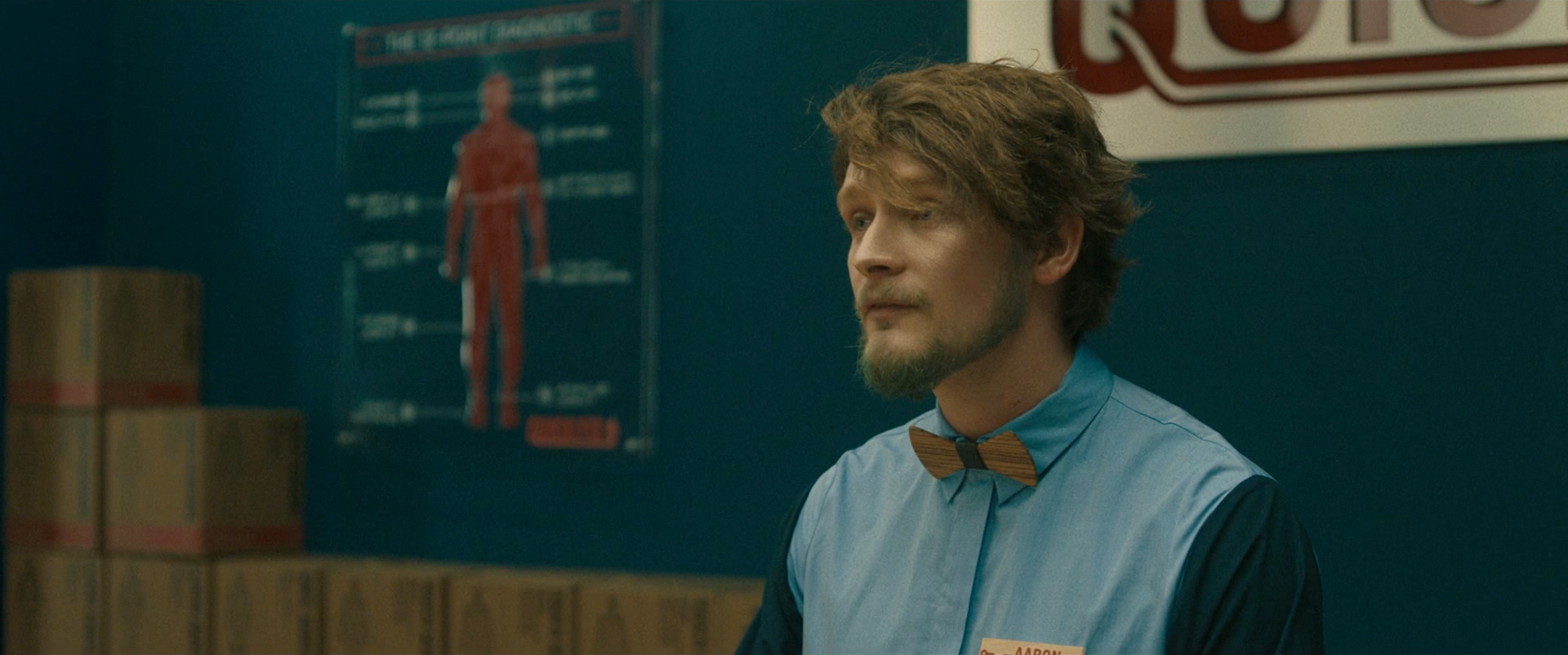
Please feast your eyes on the most fabulously ugly outfit in the movie. Aaron, the Quick Fix service rep is wearing a colorblock button-up shirt with a modern 2020s style collar in a light blue and black broadcloth with a wooden bow-tie. No doubt that this is a uniform that wears its ugliness as a way to communicate the ugliness of the business.
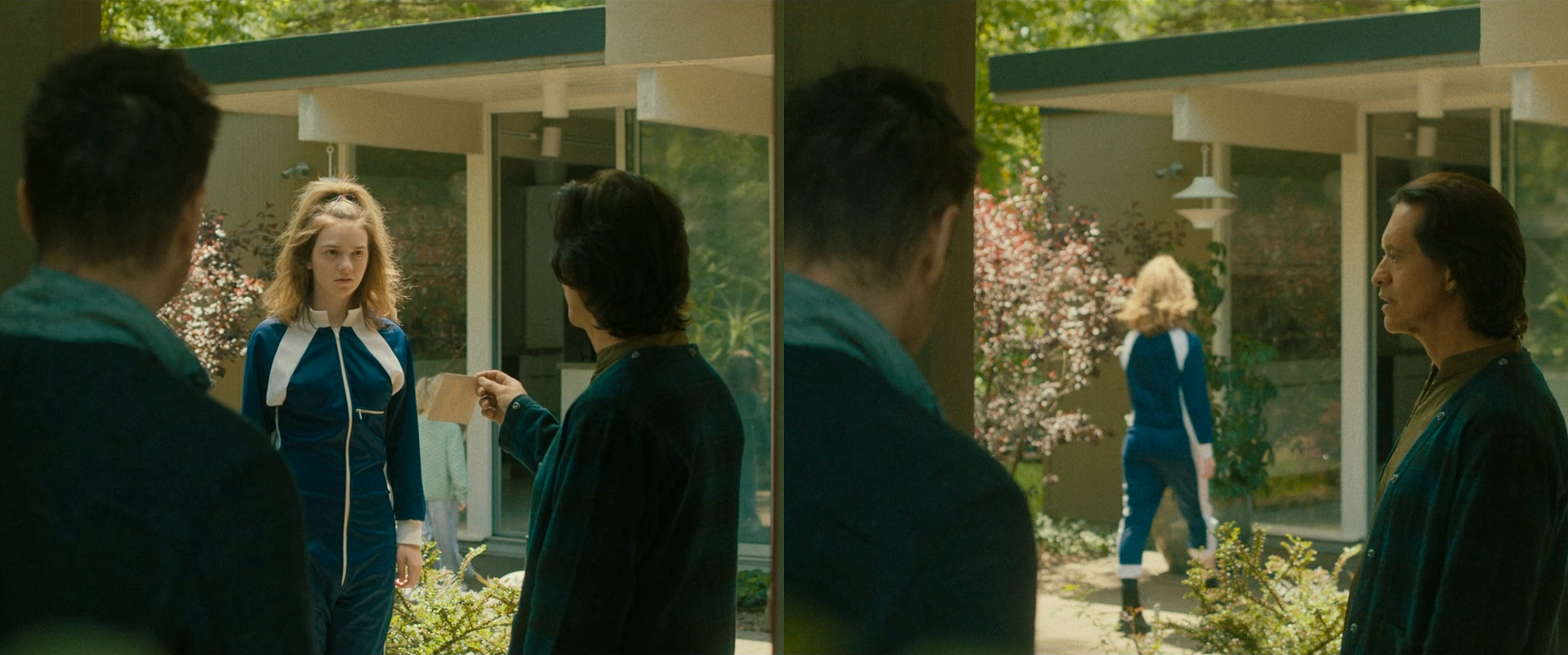
Vicky is wearing a retro-futuristic track suit in a color that is between teal (might just be the yellow filter) and navy. The suit is striped with white side and chest/armhole stripes and white cuffs on the leg and wrists. The zipper and collar is also white. This outfit stands out to me because it is the only garment to make good on the promise of futuristic fashion. Science fiction promises us streamlined, cool jumpsuits that could go from spaceship to lunar colony. What makes this funny to me is its pairing with a chavvy ponytail. The short story states more clearly that this family was created (operative word) under the fear of white replacement. In the movie, they’re presented as just a little skeezy and weird. So of course this character is wearing something corny and out of style.
Like how the costuming pokes fun at spaceage fashion, the film is constantly walking back expectations of what science fiction is. No, the robot isn’t spying on you. No, these aren’t heroes- just a middle class family working through their grief. No, their lives aren’t all that different from our own. And no, they are wearing Star Trek couture. The costuming in After Yang is grounded in recognizable shapes and fabrics that build off our own current fashion moment. From there, small details are pushed forward to innovate without alienating the emotionality of the story- because it would be hard to see ourselves in these characters if we couldn’t imagine wearing their clothes.
After Yang was directed by Kogonada and costumed by Arjun Bhasin.
Available through Showtime.
Additional credits
| Mariah Fidalgo | wardrobe supervisor |
| Felicity Gifford | key costumer |
| James Hammer | assistant costume designer |
| Jeff Horta | costume coordinator |
| Clara Poteau | tailor |
| Carl Skeris | costumer |
| Jason Frey | bg costumer |
